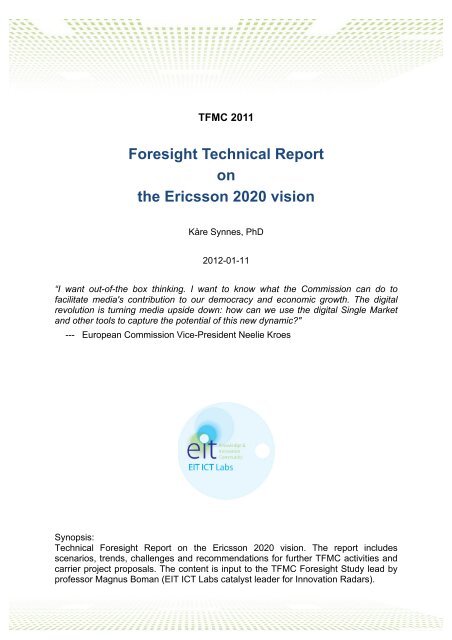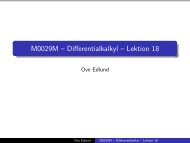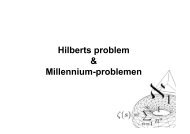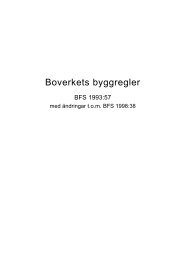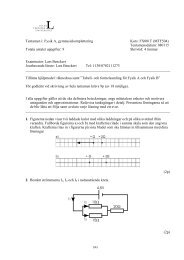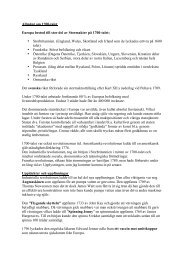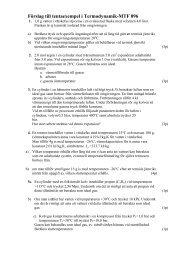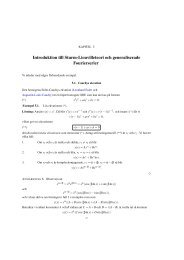Foresight Technical Report on the Ericsson 2020 vision - CDT
Foresight Technical Report on the Ericsson 2020 vision - CDT
Foresight Technical Report on the Ericsson 2020 vision - CDT
Create successful ePaper yourself
Turn your PDF publications into a flip-book with our unique Google optimized e-Paper software.
TFMC 2011<br />
<str<strong>on</strong>g>Foresight</str<strong>on</strong>g> <str<strong>on</strong>g>Technical</str<strong>on</strong>g> <str<strong>on</strong>g>Report</str<strong>on</strong>g><br />
<strong>on</strong><br />
<strong>the</strong> Ericss<strong>on</strong> <strong>2020</strong> visi<strong>on</strong><br />
Kåre Synnes, PhD<br />
2012-01-11<br />
“I want out-of-<strong>the</strong> box thinking. I want to know what <strong>the</strong> Commissi<strong>on</strong> can do to<br />
facilitate media's c<strong>on</strong>tributi<strong>on</strong> to our democracy and ec<strong>on</strong>omic growth. The digital<br />
revoluti<strong>on</strong> is turning media upside down: how can we use <strong>the</strong> digital Single Market<br />
and o<strong>the</strong>r tools to capture <strong>the</strong> potential of this new dynamic?"<br />
--- European Commissi<strong>on</strong> Vice-President Neelie Kroes<br />
Synopsis:<br />
<str<strong>on</strong>g>Technical</str<strong>on</strong>g> <str<strong>on</strong>g>Foresight</str<strong>on</strong>g> <str<strong>on</strong>g>Report</str<strong>on</strong>g> <strong>on</strong> <strong>the</strong> Ericss<strong>on</strong> <strong>2020</strong> visi<strong>on</strong>. The report includes<br />
scenarios, trends, challenges and recommendati<strong>on</strong>s for fur<strong>the</strong>r TFMC activities and<br />
carrier project proposals. The c<strong>on</strong>tent is input to <strong>the</strong> TFMC <str<strong>on</strong>g>Foresight</str<strong>on</strong>g> Study lead by<br />
professor Magnus Boman (EIT ICT Labs catalyst leader for Innovati<strong>on</strong> Radars).
Executive summary<br />
This report aims to identify trends, challenges and recommendati<strong>on</strong>s in regard of<br />
Future Media and C<strong>on</strong>tent Delivery (Networked Media). This foresight will help<br />
expose future <strong>the</strong>mes with high innovati<strong>on</strong> and business potential based <strong>on</strong> a<br />
timeframe roughly 15 years ahead, or 2030! The purpose is to create a comm<strong>on</strong><br />
outlook <strong>on</strong> <strong>the</strong> future of ICT and to establish a str<strong>on</strong>g community across EIT ICT<br />
Labs nodes and partner organizati<strong>on</strong>s.<br />
Trends<br />
1. Informati<strong>on</strong> technologies are very rapidly c<strong>on</strong>verging and evolving into<br />
pervasive services where <strong>the</strong> users no l<strong>on</strong>ger c<strong>on</strong>sider that <strong>the</strong>y interact with<br />
computing systems.<br />
2. The European citizens use of <strong>the</strong> Internet will so<strong>on</strong> become ubiquitous, where<br />
mobile access and media applicati<strong>on</strong>s based <strong>on</strong> social networks are two<br />
important enablers.<br />
3. People from Generati<strong>on</strong> E are increasingly different from previous<br />
generati<strong>on</strong>s, through acceptance and adapti<strong>on</strong> to modern computing and<br />
communicati<strong>on</strong> technologies, while c<strong>on</strong>suming media in parallel.<br />
4. Virtual communities may become <strong>the</strong> new ‘brands’ of services, offering <strong>the</strong><br />
coherent user experience for particular needs not possible to detail by a<br />
general service provider or operator.<br />
5. Service innovati<strong>on</strong> will increasingly express itself as uniquely adapted<br />
services for a world market through app stores.<br />
6. Towards pervasive access to scalable services using almost any device and<br />
any network c<strong>on</strong>necti<strong>on</strong>.<br />
7. The traditi<strong>on</strong>al role of <strong>the</strong> media distributors is fading, through <strong>the</strong> advent of<br />
digital media and Internet distributi<strong>on</strong>, where instead an almost direct<br />
c<strong>on</strong>necti<strong>on</strong> between producers and c<strong>on</strong>sumers are made possible.<br />
Challenges<br />
1. Enabling automatic creati<strong>on</strong> of micro-communities based <strong>on</strong> social c<strong>on</strong>text<br />
while using proper user and identity management.<br />
2. Increased pers<strong>on</strong>alizati<strong>on</strong> of services and new requirements <strong>on</strong> collaborati<strong>on</strong><br />
means that a major challenge lies in interoperability and simplicity of <strong>on</strong>-line<br />
communicati<strong>on</strong> services.<br />
3. Wide support of a nomadic lifestyle where access to media and informati<strong>on</strong><br />
becomes truly pervasive and ubiquitous.<br />
4. To make heterogeneous network access (2G, 3G, 4G, WiFi) pervasively<br />
available without burdening <strong>the</strong> user and while sp<strong>on</strong>soring <strong>the</strong> provisi<strong>on</strong>ing of<br />
<strong>the</strong> network access through a sustainable business model.<br />
Perspectives <strong>on</strong> <strong>the</strong> Ericss<strong>on</strong> <strong>2020</strong> visi<strong>on</strong> P age | 2 2012-01-11
5. Making devices and services pervasively available for <strong>the</strong> mobile user to<br />
enable nomadic behavioural patterns, where <strong>the</strong> user is always c<strong>on</strong>nected<br />
and has access to informati<strong>on</strong> services irrespective of time, place and device.<br />
6. Protecting privacy and integrity through a user-centric view <strong>on</strong> ownership of<br />
pers<strong>on</strong>al data (by legislative means).<br />
7. To migrate services between devices and to support ad-hoc utilizati<strong>on</strong> of<br />
devices. That is, for instance to move a call from <strong>the</strong> mobile device to a richer<br />
envir<strong>on</strong>ment like a full-scale c<strong>on</strong>ferencing envir<strong>on</strong>ment <strong>on</strong> a pers<strong>on</strong>al<br />
computer or to dynamically allocate resources from <strong>the</strong> envir<strong>on</strong>ment like<br />
m<strong>on</strong>itors, cameras, speakers, and in-put devices.<br />
8. M2M communicati<strong>on</strong> is <strong>on</strong>e of <strong>the</strong> major enablers for <strong>the</strong> Internet of Things,<br />
but at <strong>the</strong> same time a major barrier due to many network operators pricing<br />
models.<br />
Recommendati<strong>on</strong>s<br />
1. Use Sweden as a test-bed for Europe due to <strong>the</strong> widespread acceptance and<br />
adopti<strong>on</strong> of new technology.<br />
2. Utilize social computing to make (media) services more pervasive and easy to<br />
distribute and use.<br />
3. Look at how ‘<strong>the</strong> Internet of Things’ boom of devices and new requirements<br />
<strong>on</strong> pervasive network access will affect business for virtual operators.<br />
4. The future society is dependent <strong>on</strong> sustainable soluti<strong>on</strong>s for communicati<strong>on</strong><br />
and collaborati<strong>on</strong>. It is <strong>the</strong>refore inherently important to study nomadic user<br />
behavior and thus pervasive access to informati<strong>on</strong> and media.<br />
5. Study how virtual communities and ec<strong>on</strong>omies may effect innovati<strong>on</strong> and<br />
growth.<br />
The Ericss<strong>on</strong> <strong>2020</strong> visi<strong>on</strong> is maybe from 2009 but is still accurately depicting life in<br />
<strong>2020</strong> and bey<strong>on</strong>d. However, much has happened since <strong>the</strong>n that must be regarded<br />
as very disruptive to <strong>the</strong> whole ecosystem of media and communicati<strong>on</strong>. The advent<br />
of <strong>on</strong>-line stores for applicati<strong>on</strong>s and media, such as Apple Store and Android<br />
Market, and <strong>the</strong> enormous uptake of social media applicati<strong>on</strong>s, such as Facebook<br />
and Twitter, are two major changes <strong>on</strong> <strong>the</strong> market.<br />
One main comment is that virtual communities may be a major factor when it comes<br />
to new service innovati<strong>on</strong> and that service and media distributi<strong>on</strong> may be driven by<br />
unique needs facilitated by a world market at <strong>the</strong> feet of users. This enables<br />
enormous potentials for innovati<strong>on</strong>, enabled by <strong>the</strong> Internet of Things, where users<br />
can create pers<strong>on</strong>alized media services for particular needs based <strong>on</strong> access to<br />
open data and through leveraging <strong>on</strong> social networks. There are however huge<br />
challenges mainly around privacy and integrity c<strong>on</strong>cerns, M2M communicati<strong>on</strong> prices<br />
and <strong>the</strong> reducti<strong>on</strong> of complexity for pervasive systems.<br />
Perspectives <strong>on</strong> <strong>the</strong> Ericss<strong>on</strong> <strong>2020</strong> visi<strong>on</strong> P age | 3 2012-01-11
Finally, <strong>the</strong> belief is that communicati<strong>on</strong> in <strong>the</strong> future will be embedded toge<strong>the</strong>r with<br />
supporting widgets, as depicted in <strong>the</strong> scenarios. That is, using c<strong>on</strong>textual<br />
informati<strong>on</strong> to select <strong>the</strong> best communicati<strong>on</strong> envir<strong>on</strong>ment possible, whe<strong>the</strong>r it is a<br />
webpage with real-time properties or a dedicated app while involving multiple<br />
devices possibly selected by proximity and relati<strong>on</strong>. By 2030, communicati<strong>on</strong> will be<br />
embedded into virtually anything.<br />
Perspectives <strong>on</strong> <strong>the</strong> Ericss<strong>on</strong> <strong>2020</strong> visi<strong>on</strong> P age | 4 2012-01-11
Document Details<br />
Acti<strong>on</strong> Line: TFMC – Future Media and C<strong>on</strong>tent Delivery<br />
KIC Activity Name: General Acti<strong>on</strong> Line TFMC<br />
KIC Activity Identifier: 11663<br />
Task: T11 – Innovati<strong>on</strong> Radar LTU<br />
Catalyst: Innovati<strong>on</strong> Radar<br />
Deliverable: D12<br />
Type: <str<strong>on</strong>g>Foresight</str<strong>on</strong>g> <str<strong>on</strong>g>Technical</str<strong>on</strong>g> <str<strong>on</strong>g>Report</str<strong>on</strong>g><br />
Date: 2012-01-11<br />
Status: Final<br />
Partner: Luleå University of Technology (LTU)<br />
Participant: Kåre Synnes, PhD, LTU/PMC, unicorn@ltu.se (editor)<br />
Perspectives <strong>on</strong> <strong>the</strong> Ericss<strong>on</strong> <strong>2020</strong> visi<strong>on</strong> P age | 5 2012-01-11
C<strong>on</strong>tributors<br />
Johan Kristianss<strong>on</strong>, PhD, Ericss<strong>on</strong>, johan.j.kristianss<strong>on</strong>@ericss<strong>on</strong>.com<br />
Daniel Enström, Ericss<strong>on</strong>, daniel.enstrom@ericss<strong>on</strong>.com<br />
Henrik Abramowicz, Ericss<strong>on</strong>, henrik.abramowicz@ericss<strong>on</strong>.com<br />
Stefan Håkanss<strong>on</strong>, Ericss<strong>on</strong>, stefan.lk.hakanss<strong>on</strong>@ericss<strong>on</strong>.com<br />
Kåre Synnes, PhD, LTU/PMC, unicorn@ltu.se<br />
Michael Nilss<strong>on</strong>, LTU/<strong>CDT</strong>, michael.nilss<strong>on</strong>@ltu.se<br />
Juwel Rana, Lic., LTU/PMC, juwel.rana@ltu.se<br />
Prof Peter Parnes, PhD, LTU/PMC, peter.parnes@ltu.se<br />
Prof Magnus Boman, PhD, SIC/KTH, mab@sics.se<br />
Mikael Börjes<strong>on</strong>, LTU/<strong>CDT</strong>, mikael.borjes<strong>on</strong>@ltu.se<br />
Erik Kruse, Ericss<strong>on</strong>, erik.kruse@ericss<strong>on</strong>.com<br />
Nikolaus Frank, Frank Etc., nikolaus@frank-etc.se<br />
Note that c<strong>on</strong>tributi<strong>on</strong>s from Ericss<strong>on</strong> should be seen as individual input and not as officially<br />
endorsed statements by Ericss<strong>on</strong>.<br />
Perspectives <strong>on</strong> <strong>the</strong> Ericss<strong>on</strong> <strong>2020</strong> visi<strong>on</strong> P age | 6 2012-01-11
Table of C<strong>on</strong>tents<br />
Executive summary.......................................................................................................................................... 2<br />
Document Details .............................................................................................................................................. 5<br />
C<strong>on</strong>tributors ........................................................................................................................................................ 6<br />
Table of C<strong>on</strong>tents............................................................................................................................................... 7<br />
Foreword by Henrik Abramowicz ............................................................................................................. 8<br />
1 Introducti<strong>on</strong> ...............................................................................................................................................10<br />
1.1 Outline..................................................................................................................................................10<br />
1.2 The Digtal Agenda and EU Media Futures Forum.............................................................10<br />
1.3 Exp<strong>on</strong>ential Growth of Technology.........................................................................................11<br />
1.4 Swedes and <strong>the</strong> Internet 2011 ..................................................................................................13<br />
1.5 Generati<strong>on</strong> E......................................................................................................................................14<br />
1.6 Scenario – C<strong>on</strong>textual Communicati<strong>on</strong> with Dynamic Apps ........................................14<br />
1.7 Scenario -‐ Social Group Communicati<strong>on</strong> (Media Versi<strong>on</strong>)............................................15<br />
1.8 Social Networking and Group Communicati<strong>on</strong>..................................................................17<br />
1.8.1 Social Graphs ............................................................................................................................18<br />
1.8.2 Social Recommendati<strong>on</strong> ......................................................................................................19<br />
1.8.3 Social Recommendati<strong>on</strong> Framework.............................................................................20<br />
1.8.4 Socially Aware Applicati<strong>on</strong>s...............................................................................................21<br />
2 Outside View <strong>on</strong> <strong>the</strong> Ericss<strong>on</strong> <strong>2020</strong> Visi<strong>on</strong>...................................................................................23<br />
2.1 Likely Truths .....................................................................................................................................23<br />
2.2 Brands and Pipes.............................................................................................................................28<br />
2.3 User choice.........................................................................................................................................29<br />
2.4 Green shift ..........................................................................................................................................30<br />
2.5 All-‐inclusive .......................................................................................................................................31<br />
3 <str<strong>on</strong>g>Foresight</str<strong>on</strong>g> Results .....................................................................................................................................33<br />
3.1 Trends ..................................................................................................................................................33<br />
3.2 Challenges...........................................................................................................................................33<br />
3.3 Recommendati<strong>on</strong>s ..........................................................................................................................34<br />
4 C<strong>on</strong>clusi<strong>on</strong>s ................................................................................................................................................35<br />
References..........................................................................................................................................................36<br />
Perspectives <strong>on</strong> <strong>the</strong> Ericss<strong>on</strong> <strong>2020</strong> visi<strong>on</strong> P age | 7 2012-01-11
Foreword by Henrik Abramowicz<br />
Ericss<strong>on</strong> is a company that since 1876 has been leading <strong>the</strong> telecommunicati<strong>on</strong><br />
industry based <strong>on</strong> c<strong>on</strong>stant creativity and innovati<strong>on</strong>. Ericss<strong>on</strong> was in November<br />
2011 recognized as a Thoms<strong>on</strong> Reuters 2011 Top 100 Global Innovator 1 , based<br />
<strong>on</strong> achievements as <strong>on</strong>e of <strong>the</strong> world’s most innovative companies. Innovati<strong>on</strong>s at<br />
Ericss<strong>on</strong> empower people, business and society to improve <strong>the</strong> quality of everyday<br />
life and society at large. The future Networked Society is a visi<strong>on</strong> where everything<br />
that can benefit from a c<strong>on</strong>necti<strong>on</strong> will have <strong>on</strong>e. This will help to solve global<br />
challenges e.g. related to educati<strong>on</strong>, poverty and sustainability. Ericss<strong>on</strong>’s mobile<br />
and fixed networks, multimedia soluti<strong>on</strong>s and telecom services make a real<br />
difference to people’s lives, and <strong>the</strong> world we live in.<br />
The Ericss<strong>on</strong> <strong>2020</strong> visi<strong>on</strong> is a result from <strong>the</strong> Life in <strong>2020</strong> project, which was lead<br />
by Erik Kruse and involved more than 450 experts both from Ericss<strong>on</strong> and from<br />
external organizati<strong>on</strong>s such as McKinsey, <strong>the</strong> Institute for <strong>the</strong> Future in California<br />
and <strong>the</strong> Copenhagen Institute for Future Studies. The participants predicted socioec<strong>on</strong>omic<br />
trends, c<strong>on</strong>sumer buying patterns and sustainability of technologies to<br />
determine how life will have changed in <strong>the</strong> next decade based <strong>on</strong> social attitudes<br />
towards green products, new industries providing employment, and <strong>the</strong> growing<br />
elderly populati<strong>on</strong>.<br />
15 pers<strong>on</strong>as from <strong>2020</strong> and <strong>the</strong> technology <strong>the</strong>y use in <strong>the</strong>ir daily lives are presented<br />
<strong>on</strong> <strong>the</strong> Ericss<strong>on</strong> <strong>2020</strong> website 2 toge<strong>the</strong>r with 70 hypo<strong>the</strong>tical mobile devices and<br />
1 The initiative issued by <strong>the</strong> IP Soluti<strong>on</strong>s business of Thoms<strong>on</strong> Reuters, providers of intelligent<br />
intellectual property soluti<strong>on</strong>s and informati<strong>on</strong>, analyzes patent data and related metrics in a<br />
proprietary methodology to identify <strong>the</strong> most influential organizati<strong>on</strong>s globally.<br />
2 http://www.ericss<strong>on</strong>.com/campaign/<strong>2020</strong>_search_applicati<strong>on</strong>/<br />
Perspectives <strong>on</strong> <strong>the</strong> Ericss<strong>on</strong> <strong>2020</strong> visi<strong>on</strong> P age | 8 2012-01-11
services for <strong>the</strong>se characters, delivered by 22 hypo<strong>the</strong>tical companies. An example<br />
is <strong>the</strong> spider computer depicted above, that projects an image <strong>on</strong> a flat surface while<br />
working as a virtual input device.<br />
The objective of this report is to give an additi<strong>on</strong>al outside view <strong>on</strong> <strong>the</strong> Ericss<strong>on</strong> <strong>2020</strong><br />
visi<strong>on</strong>, specifically in regards of EIT ICT Labs <strong>the</strong>matic area of Future Media C<strong>on</strong>tent<br />
and Delivery (TFMC). The purpose is to direct <strong>the</strong> future TFMC agenda and to build<br />
scenarios for c<strong>on</strong>tinued research efforts, so that future innovati<strong>on</strong> is fostered and<br />
sp<strong>on</strong>sored by Ericss<strong>on</strong> within <strong>the</strong> EIT framework.<br />
Even if <strong>the</strong> report has taken its starting point from Ericss<strong>on</strong> and a number of<br />
c<strong>on</strong>tributors are from Ericss<strong>on</strong> <strong>the</strong> statements and input should be seen as individual<br />
input and not as officially endorsed statements by Ericss<strong>on</strong>.<br />
---------------------------------------------------<br />
Henrik Abramowicz<br />
Ericss<strong>on</strong> AB<br />
EIT ICT Labs Thematic Activity Line Leader for Future Media and C<strong>on</strong>tent Delivery<br />
Perspectives <strong>on</strong> <strong>the</strong> Ericss<strong>on</strong> <strong>2020</strong> visi<strong>on</strong> P age | 9 2012-01-11
1 Introducti<strong>on</strong><br />
This technical report is part of <strong>the</strong> EIT ICT Labs <str<strong>on</strong>g>Foresight</str<strong>on</strong>g> Study and Innovati<strong>on</strong><br />
Radar within <strong>the</strong> <strong>the</strong>matic acti<strong>on</strong> line of Future Media C<strong>on</strong>tent and Delivery (TFMC).<br />
The report aims to identify key scenarios, trends, challenges and recommendati<strong>on</strong>s<br />
in regard of Future Media and C<strong>on</strong>tent Delivery. This foresight will help expose future<br />
<strong>the</strong>mes with high innovati<strong>on</strong> and business potential based <strong>on</strong> a timeframe at least 15<br />
years ahead, or 2030! The purpose is to create a comm<strong>on</strong> outlook <strong>on</strong> <strong>the</strong> future of<br />
ICT and to establish a str<strong>on</strong>g community across EIT ICT Labs nodes and partner<br />
organizati<strong>on</strong>s.<br />
1.1 Outline<br />
Chapter 1 introduces characteristics for future media delivery while also presenting a<br />
set of related scenarios. Chapter 2 gives an outside view of <strong>the</strong> Ericss<strong>on</strong> <strong>2020</strong> visi<strong>on</strong><br />
and its implicati<strong>on</strong>s for EIT ICT Labs. Chapter 3 presents trends, implicati<strong>on</strong>s and<br />
recommendati<strong>on</strong>s with a 2030 baseline in mind. Chapter 4 draws c<strong>on</strong>clusi<strong>on</strong>s for<br />
future EIT ICT Labs activities.<br />
1.2 The Digtal Agenda and EU Media Futures Forum<br />
The European Commissi<strong>on</strong> (EC) lauched a Digital Agenda 3 that put emphasis <strong>on</strong><br />
Europe’s development towards a leading positi<strong>on</strong> in <strong>the</strong> world for digital services, for<br />
instance through large investments in broadband infrastructure and acti<strong>on</strong>s towards<br />
making Europe a digital single market.<br />
EC Vice-President Neelie Kroes established a Task Force 4 and a Media Futures<br />
Forum 5 to debate how to improve <strong>the</strong> policy framework for European media<br />
industries, initially by focusing <strong>on</strong> <strong>the</strong> impacts of <strong>the</strong> digital revoluti<strong>on</strong> <strong>on</strong> European<br />
media industries and to provide input designed to foster a pluralist media sector with<br />
quality journalism in spite of recent declining revenues.<br />
“I want out-of-<strong>the</strong> box thinking. I want to know what <strong>the</strong> Commissi<strong>on</strong> can do to<br />
facilitate media's c<strong>on</strong>tributi<strong>on</strong> to our democracy and ec<strong>on</strong>omic growth. The digital<br />
revoluti<strong>on</strong> is turning media upside down: how can we use <strong>the</strong> digital Single Market<br />
and o<strong>the</strong>r tools to capture <strong>the</strong> potential of this new dynamic?"<br />
--- European Commissi<strong>on</strong> Vice-President Neelie Kroes<br />
3 http://ec.europa.eu/digital-agenda/index_en.htm<br />
4 http://ec.europa.eu/informati<strong>on</strong>_society/media_taskforce/index_en.htm<br />
5<br />
http://europa.eu/rapid/pressReleasesActi<strong>on</strong>.do?reference=IP/11/1506&format=HTML&aged=0&langu<br />
age=EN&guiLanguage=en<br />
Perspectives <strong>on</strong> <strong>the</strong> Ericss<strong>on</strong> <strong>2020</strong> visi<strong>on</strong> P age | 10 2012-01-11
The Commissi<strong>on</strong> will be looking for Forum members to foster debate throughout<br />
2012, by bringing ambitious pers<strong>on</strong>al thinking to <strong>the</strong> Forum ra<strong>the</strong>r than homogenized<br />
industry or company views. This enforces <strong>the</strong> commissi<strong>on</strong>’s focus <strong>on</strong> <strong>the</strong> importance<br />
of individual c<strong>on</strong>tra large enterprises. The Forum will draw <strong>on</strong> <strong>the</strong> knowledge and<br />
experience of more than 20 pers<strong>on</strong>alities from <strong>the</strong> publishing, broadcasting,<br />
advertising, telecommunicati<strong>on</strong>s, equipment manufacturers, social media and <strong>on</strong>line<br />
industries.<br />
EU Media Futures Forum topics:<br />
1) What are <strong>the</strong> big trends in <strong>the</strong> media industry in Europe and globally?<br />
2) What is <strong>the</strong> impact of <strong>the</strong>se trends <strong>on</strong> business models, competiti<strong>on</strong>, pluralism<br />
and c<strong>on</strong>tent creati<strong>on</strong> in Europe?<br />
3) What are <strong>the</strong> main opportunities and barriers in creating a digital media<br />
c<strong>on</strong>tent market in Europe? What needs to be d<strong>on</strong>e to attain or overcome<br />
<strong>the</strong>m?<br />
4) How can <strong>the</strong> European media industries best benefit from <strong>the</strong> technological<br />
developments to enhance <strong>the</strong>ir competitiveness globally?<br />
5) What are <strong>the</strong> c<strong>on</strong>diti<strong>on</strong>s for sustainable business models that can deliver<br />
quality journalism?<br />
This foresight technical report can thus be used toge<strong>the</strong>r with <strong>the</strong> TFMC <str<strong>on</strong>g>Foresight</str<strong>on</strong>g><br />
Study as an input from EIT ICT Labs to at least topics 1-4.<br />
1.3 Exp<strong>on</strong>ential Growth of Technology<br />
”We w<strong>on</strong>’t experience 100 years of progress in <strong>the</strong> 21st century - it will be more like 20,000<br />
years of progress (at today’s rate). There’s even exp<strong>on</strong>ential growth in <strong>the</strong> rate of<br />
exp<strong>on</strong>ential growth.”<br />
- Ray Kurzweil<br />
Figure 1, Kurzweil’s predicti<strong>on</strong>s based <strong>on</strong> Moore’s Law (Courtesy of WikiPedia).<br />
Perspectives <strong>on</strong> <strong>the</strong> Ericss<strong>on</strong> <strong>2020</strong> visi<strong>on</strong> P age | 11 2012-01-11
The predicti<strong>on</strong>s made by Gord<strong>on</strong> Moore and Ray Kurzweil builds <strong>on</strong> that <strong>the</strong> number<br />
of transistors that can be placed inexpensively <strong>on</strong> an integrated circuit doubles<br />
approximately every two years (Moore’s Law). This exp<strong>on</strong>ential growth is a<br />
phenomen<strong>on</strong> found in regards of many related technologies and can according to<br />
Kurzweil be explained by <strong>the</strong> fact that each technological development builds <strong>on</strong><br />
previous <strong>on</strong>es, thus accelerates accordingly. 6 By 2030 <strong>the</strong> cost of computing will<br />
have passed <strong>the</strong> point where we for a 1000 USD could buy a computer with an equal<br />
capacity to <strong>the</strong> human brain (see figure 1 above).<br />
Figure 2, Development in Speed and Latency (Courtesy of Ericss<strong>on</strong> Research)<br />
This accelerati<strong>on</strong> is reflected <strong>on</strong> network technologies (as depicted in figure 2<br />
above). A predicti<strong>on</strong> is that we by 2030 will have near ubiquitous network access<br />
through interworking heterogeneous networks. Recently developed technologies like<br />
software-defined radio and antennas integrated into LCD glass etc, show that <strong>the</strong><br />
Internet technologies can be pervasively integrated into almost anything.<br />
Ericss<strong>on</strong>’s predicti<strong>on</strong> 7,8 is that mobile broadband is to grow explosively, with a<br />
subscriber growth to 3.4 billi<strong>on</strong> by 2015, and that up to 50 billi<strong>on</strong> devices are<br />
expected to be c<strong>on</strong>nected by <strong>2020</strong>. Ericss<strong>on</strong> also envisi<strong>on</strong> <strong>the</strong> social web of<br />
things 9 where everything is c<strong>on</strong>nected and acts within a social c<strong>on</strong>text. A challenge<br />
will be to integrate <strong>the</strong>se technologies pervasively into society.<br />
Alan Kay, Apple Inc, stated that what we are experiencing is “<strong>the</strong> 3 rd paradigm of<br />
computing”, where ubiquitous computing (<strong>on</strong>e pers<strong>on</strong>, many computers) will<br />
6 Transcendent Man: Accelerati<strong>on</strong> Technology<br />
http://youtu.be/X-cy4_Z9Rd0<br />
7 As described in <strong>the</strong> Ericss<strong>on</strong> <strong>2020</strong> visi<strong>on</strong>.<br />
8 Ericss<strong>on</strong> Business Review, p.43<br />
http://www.ericss<strong>on</strong>.com/ericss<strong>on</strong>/corpinfo/publicati<strong>on</strong>s/ericss<strong>on</strong>_business_review/pdf/310/310_ebr_<br />
lowres.pdf<br />
9 The Social Web of Things<br />
http://youtu.be/ZiwnyO3xygA<br />
Perspectives <strong>on</strong> <strong>the</strong> Ericss<strong>on</strong> <strong>2020</strong> visi<strong>on</strong> P age | 12 2012-01-11
eplace <strong>the</strong> paradigms of mainframes (<strong>on</strong>e computer, many people) and pers<strong>on</strong>al<br />
computers (<strong>on</strong>e pers<strong>on</strong>, <strong>on</strong>e computer). The advent of cloud computing hints at a<br />
more complex reality where all paradigms are intermixed. By 2030, this may be<br />
seamlessly integrated in a way that we no l<strong>on</strong>ger think of computers and interact with<br />
technologies in <strong>the</strong> same way we do with automatic doors today – so that technology<br />
becomes a pervasive part of our daily lives.<br />
This will have a tremendous effect <strong>on</strong> society until 2030! The challenges for future<br />
media delivery are possibly <strong>on</strong>ly partly technological and instead mainly <strong>on</strong><br />
interacti<strong>on</strong> design and ethics (privacy and integrity).<br />
1.4 Swedes and <strong>the</strong> Internet 2011<br />
Sweden is in many ways a forerunner in regards of Internet usage in Europe and in<br />
<strong>the</strong> world, with am<strong>on</strong>g <strong>the</strong> most mobile ph<strong>on</strong>es and computers per capita. A recent<br />
report 10 shows that:<br />
• 88% of <strong>the</strong> populati<strong>on</strong> over 12 years has access to <strong>the</strong> Internet<br />
• 85% of <strong>the</strong> populati<strong>on</strong> have access to broadband at home<br />
• 81% of all Internet users use <strong>the</strong> Internet <strong>on</strong> a daily basis<br />
• 90% of <strong>the</strong> populati<strong>on</strong> has a pers<strong>on</strong>al computer (80% a laptop)<br />
• 2 of 3 in <strong>the</strong> younger age groups use mobile Internet<br />
• 52% of <strong>the</strong> populati<strong>on</strong> use social networks<br />
• 57% of <strong>the</strong> populati<strong>on</strong> downloads and listen to music <strong>on</strong>line<br />
• 50% of <strong>the</strong> populati<strong>on</strong> play digital games<br />
• 50% of all 3-years olds have used <strong>the</strong> Internet at least occasi<strong>on</strong>ally<br />
Figure 3, Kindergarten and WiFi<br />
As stated in <strong>the</strong> .SE report; an analysis of shared user patterns dem<strong>on</strong>strates that<br />
<strong>the</strong>re are two extreme groups: advanced enthusiasts who use <strong>the</strong> Internet’s full<br />
range of possibilities more than every<strong>on</strong>e else, and <strong>the</strong> cautious group who is more<br />
restrictive and cautious in its use. In between <strong>the</strong>se are <strong>the</strong> traditi<strong>on</strong>alists, who<br />
10 .SE report ”Svenskarna och Internet 2011” <strong>on</strong> Internet Statistics in Sweden.<br />
http://www.iis.se/docs/SOI2011.pdf<br />
Perspectives <strong>on</strong> <strong>the</strong> Ericss<strong>on</strong> <strong>2020</strong> visi<strong>on</strong> P age | 13 2012-01-11
primarily use <strong>the</strong> Internet to acquire informati<strong>on</strong>, and <strong>the</strong> modernists, who are more<br />
interested in <strong>the</strong> Internet’s communicative, entertaining and social aspects. However,<br />
four of ten users are more cautious and restrictive in <strong>the</strong>ir Internet use.<br />
Using Sweden as a test-bed for future media services is thus a good idea, given <strong>the</strong><br />
number of Internet users and <strong>the</strong> maturity of <strong>on</strong>-line communities.<br />
1.5 Generati<strong>on</strong> E<br />
Many anthropologists states that <strong>the</strong>re are great generati<strong>on</strong>al differences that can be<br />
seen today, where <strong>the</strong> new generati<strong>on</strong> is intrinsically accustomed to computers and<br />
mobile technologies. Ida Hult, CEO of Trendethnography, defines <strong>the</strong>se as “Moklofs”<br />
or Mobile kids with lots of friends. This Generati<strong>on</strong> E is used to getting rapid<br />
feedback <strong>on</strong> <strong>the</strong>ir opini<strong>on</strong>s and acti<strong>on</strong>s, through a big flora of tools 11 .<br />
“Those ages 8 to 18 spend more than 7,5 hours a day with such devices, compared<br />
with less than 6,5 hours 5 years ago, when <strong>the</strong> study was last c<strong>on</strong>ducted. And that<br />
does not count <strong>the</strong> 1,5 hours that youths spend texting, or <strong>the</strong> 0,5 hour <strong>the</strong>y talk <strong>on</strong><br />
<strong>the</strong>ir cellph<strong>on</strong>es. And because so many of <strong>the</strong>m are multitasking — say, surfing <strong>the</strong><br />
Internet while listening to music — <strong>the</strong>y pack <strong>on</strong> average nearly 11 hours of media<br />
c<strong>on</strong>tent into that 7,5 hours.”<br />
-- Kevin Drum, Mo<strong>the</strong>rJ<strong>on</strong>es.com<br />
A challenge is to study phenomena related to our new generati<strong>on</strong>s so that we build a<br />
society that gives <strong>the</strong> best possibilities for enabling new behavior across<br />
generati<strong>on</strong>s, thus empowering people to change throughout society.<br />
1.6 Scenario – C<strong>on</strong>textual Communicati<strong>on</strong> with Dynamic Apps<br />
The core idea behind c<strong>on</strong>textual communicati<strong>on</strong> with dynamic apps is to enhance<br />
traditi<strong>on</strong>ally voice-<strong>on</strong>ly communicati<strong>on</strong>s with dedicated and specialized electr<strong>on</strong>ic<br />
applicati<strong>on</strong>s as ‘helpers’.<br />
Curt is 18 years old and a fanatic gamer, and today he has been at a gaming party at<br />
<strong>on</strong>e of his friends. They decide to order some pizza, so Curt uses his gaming<br />
machine to google for nearby pizzerias with a good renomé. He finds an interactive<br />
website where he can order pizzas, which also provides a dynamic app that initially<br />
presents <strong>the</strong> menu and how to reach <strong>the</strong> pizzeria. He order a stack of pizzas for later<br />
and goes back to gaming.<br />
11 DN 2010-06-15 ”Generati<strong>on</strong> E går sin egen väg”<br />
http://www.dn.se/insidan/insidan-hem/generati<strong>on</strong>-e-gar-sin-egen-vag<br />
Perspectives <strong>on</strong> <strong>the</strong> Ericss<strong>on</strong> <strong>2020</strong> visi<strong>on</strong> P age | 14 2012-01-11
A while later <strong>the</strong> pizzeria calls Curt <strong>on</strong> his mobile, because he is currently using <strong>the</strong><br />
gaming computer for talking to gamers, which brings <strong>the</strong> dynamic app up <strong>on</strong> his<br />
mobile instead. They are out of shrimps and propose a selecti<strong>on</strong> of o<strong>the</strong>r choices.<br />
Curt selects something else and goes back to gaming. He keeps <strong>the</strong> app active <strong>on</strong><br />
his mobile which now also shows <strong>the</strong> locati<strong>on</strong> of <strong>the</strong> delivery and <strong>the</strong> time that <strong>the</strong><br />
pizzas are predicted to arrive. 5 minutes before <strong>the</strong> delivery arrives a sound alerts<br />
Curt and <strong>the</strong> gamers that <strong>the</strong> pizzas so<strong>on</strong> will arrive and that its time for a gaming<br />
break.<br />
After <strong>the</strong> pizzas <strong>the</strong> gamers decides to go downtown to watch a movie using Curt’s<br />
friend Johan’s SAAB. Halfway downtown <strong>the</strong> car starts to misfire and <strong>the</strong>y stop at <strong>the</strong><br />
side of <strong>the</strong> road. Curt brings up his mobile and searches for <strong>the</strong> representati<strong>on</strong> of <strong>the</strong><br />
car by browsing devices by proximity and social relati<strong>on</strong>. The car agent suggests<br />
c<strong>on</strong>tacting <strong>the</strong> nearest workshop, which Curt agrees <strong>on</strong> and a dynamic app is<br />
initialized. The workshop gets <strong>the</strong> current status of <strong>the</strong> car toge<strong>the</strong>r with <strong>the</strong> history of<br />
its maintenance, which also is presented to Curt. Curt uses embedded<br />
communicati<strong>on</strong> channel in <strong>the</strong> app to talk to <strong>the</strong> mechanic without need to make a<br />
call specifically and describe <strong>the</strong> problem with <strong>the</strong> car.<br />
This scenario depicts communicati<strong>on</strong> envir<strong>on</strong>ments embedded into webpages or<br />
apps that also can supply widgets dynamically for specific purposes based <strong>on</strong><br />
c<strong>on</strong>textual needs. That is, all media associated with a task is automatically provided<br />
pervasively as an integrated service for <strong>the</strong> user (in a webpage or an app). Note that<br />
<strong>the</strong> communicati<strong>on</strong> envir<strong>on</strong>ment can utilize multiple devices based <strong>on</strong> c<strong>on</strong>text such<br />
as activity, locati<strong>on</strong> and relati<strong>on</strong>. Everything is stored in <strong>the</strong> cloud, which enables <strong>the</strong><br />
user to find informati<strong>on</strong> retroactively (find <strong>the</strong> pizzerias that I have ordered from<br />
before).<br />
1.7 Scenario - Social Group Communicati<strong>on</strong> (Media Versi<strong>on</strong>)<br />
The following scenario about Amanda and her friends points out <strong>the</strong> usefulness of a<br />
social recommendati<strong>on</strong> framework to arrange a party.<br />
Amanda is a very socially active girl and she spends a lot of her free time<br />
communicating with large number of her c<strong>on</strong>tacts. Most of <strong>the</strong>se c<strong>on</strong>tacts are family,<br />
friends and colleagues, while some <strong>on</strong>ly share comm<strong>on</strong> interests or goals. She<br />
communicates with <strong>the</strong>m <strong>on</strong> Facebook, by twittering or through mobile calls, but she<br />
struggles with keeping herself updated with <strong>the</strong> most important activities in her social<br />
networks. Her 30th birthday is coming up, so she plans <strong>on</strong> having a party toge<strong>the</strong>r<br />
with Melvin and Ebba, two of her friends at work that also have birthdays <strong>the</strong> same<br />
m<strong>on</strong>th as her. She gives <strong>the</strong>m a call and <strong>the</strong>y start planning what to do and whom to<br />
invite.<br />
They open up <strong>the</strong>ir group management tool which first filters out all <strong>the</strong>ir shared<br />
c<strong>on</strong>tacts that <strong>the</strong>y have no pers<strong>on</strong>al relati<strong>on</strong> to and <strong>the</strong>n prioritizes <strong>the</strong> remaining<br />
Perspectives <strong>on</strong> <strong>the</strong> Ericss<strong>on</strong> <strong>2020</strong> visi<strong>on</strong> P age | 15 2012-01-11
c<strong>on</strong>tacts based <strong>on</strong> how much <strong>the</strong>y interact and how str<strong>on</strong>g <strong>the</strong>ir social relati<strong>on</strong> is.<br />
Several of <strong>the</strong>ir c<strong>on</strong>tacts are quite busy pers<strong>on</strong>s but <strong>the</strong>y manage to select a date<br />
that fits <strong>the</strong> majority of <strong>the</strong>m. They decide to invite 50 of <strong>the</strong> pers<strong>on</strong>s and generate a<br />
group invitati<strong>on</strong> for <strong>the</strong> party, by recording a short video with Ebba’s mobile ph<strong>on</strong>e<br />
and that is automatically shared to Amanda and Melvin. Amanda <strong>the</strong>n sends out <strong>the</strong><br />
invitati<strong>on</strong>s using any of <strong>the</strong> c<strong>on</strong>venient tools for example, Facebook to users<br />
frequently <strong>the</strong>re and by SMS to <strong>the</strong> o<strong>the</strong>rs, while starting a Twitter feed about <strong>the</strong><br />
<strong>on</strong>going party activities inside <strong>the</strong> invited group members.<br />
The party at Amanda’s place is now <strong>on</strong>! John is a friend of a friend and tagged al<strong>on</strong>g<br />
to <strong>the</strong> party. He takes a photo of his friend and Melvin making funny faces, and is<br />
<strong>the</strong>n notified of <strong>the</strong> party group to which he selects to share media to and which give<br />
him access to <strong>the</strong> media devices at Amanda’s place. John laughs as <strong>the</strong> photo turns<br />
up <strong>on</strong> Amanda’s TV, which shows media from <strong>the</strong> party. Ebba walks up to John and<br />
starts discussing music and <strong>the</strong>y find out that <strong>the</strong>y both attended <strong>the</strong> same c<strong>on</strong>cert.<br />
John selects his favorite s<strong>on</strong>g from <strong>the</strong> c<strong>on</strong>cert and pushes that to <strong>the</strong> top of <strong>the</strong><br />
party play list, which mainly c<strong>on</strong>sists of s<strong>on</strong>gs that Amanda, Ebba and Melvin has in<br />
<strong>the</strong>ir private playlists but pruned and sorted by <strong>the</strong> interests of all people at <strong>the</strong> party.<br />
The scenario illustrates that simple group management can be very useful.<br />
Informati<strong>on</strong> about Amanda is harnessed by <strong>the</strong> group management tool, which<br />
utilizes a social recommendati<strong>on</strong> engine to list, filter and prioritize her c<strong>on</strong>tacts and<br />
media based <strong>on</strong> <strong>the</strong> related social strengths. This is d<strong>on</strong>e by creating a weighted<br />
social graph that can be pruned in many ways; here by using additi<strong>on</strong>al informati<strong>on</strong><br />
from Melvin and Ebba, as well as presence informati<strong>on</strong> from <strong>the</strong>ir c<strong>on</strong>tacts (calendar<br />
data). Knowledge about how she usually communicates with <strong>the</strong> pers<strong>on</strong>s she would<br />
like to invite is used to send out <strong>the</strong> invitati<strong>on</strong>s in <strong>the</strong> most suitable way to each and<br />
every <strong>on</strong>e <strong>on</strong> <strong>the</strong> invitati<strong>on</strong> list. She also selects a few pers<strong>on</strong>s from <strong>the</strong> invitati<strong>on</strong> list<br />
by pruning it based <strong>on</strong> interests, with <strong>the</strong> purpose of getting help with cooking <strong>the</strong><br />
party food.<br />
The scenario also shows how media can be shared in a dynamic group and how <strong>the</strong><br />
social graph can be used to invite and manage access to devices in <strong>the</strong> vicinity. It<br />
also shows how presence informati<strong>on</strong> can be utilized toge<strong>the</strong>r with social filtering<br />
and prioritizati<strong>on</strong> for <strong>the</strong> purpose of initiating group communicati<strong>on</strong> am<strong>on</strong>g users and<br />
to select media from a larger set based <strong>on</strong> pers<strong>on</strong>al preferences of a group of<br />
pers<strong>on</strong>s. Note also that media and devices are seamlessly presented to <strong>the</strong> user,<br />
where devices automatically becomes available based <strong>on</strong> proximity and c<strong>on</strong>text.<br />
Figure 4 depicts a Home Media Gateway from <strong>the</strong> Ericss<strong>on</strong> <strong>2020</strong> visi<strong>on</strong>, which could<br />
work as described in <strong>the</strong> scenario where media is selected based <strong>on</strong> c<strong>on</strong>text for a<br />
social network.<br />
Perspectives <strong>on</strong> <strong>the</strong> Ericss<strong>on</strong> <strong>2020</strong> visi<strong>on</strong> P age | 16 2012-01-11
Figure 4, Ericss<strong>on</strong> <strong>2020</strong> visi<strong>on</strong> of a Home Media Gateway (courtesy of<br />
Ericss<strong>on</strong>/Frank etc).<br />
1.8 Social Networking and Group Communicati<strong>on</strong><br />
On-line social networking and communicati<strong>on</strong> services are increasingly popular<br />
methods to communicate with friends, family and communities. Statistics shows that<br />
users of services like Facebook and Twitter stretches across geographical locati<strong>on</strong>s,<br />
professi<strong>on</strong>s, age groups and habits. Smart mobile devices with Internet c<strong>on</strong>nectivity<br />
simplifies access to <strong>the</strong>se services at anytime and from almost anywhere. However,<br />
<strong>the</strong> huge amount of user-generated c<strong>on</strong>tent makes it difficult to identify useful<br />
informati<strong>on</strong>. A challenge is to create micro-communities where users may join from<br />
heterogeneous social networks, for instance for forming dynamic groups linked to<br />
enhanced communicati<strong>on</strong> envir<strong>on</strong>ments using not <strong>on</strong>ly audio and video but also<br />
apps, while maintaining proper user and identity management. The increasing<br />
number of social networks and communicati<strong>on</strong> services are also creating new<br />
challenges in social media c<strong>on</strong>tent filtering, micro-community discovery, and<br />
automatic group communicati<strong>on</strong> initializati<strong>on</strong>.<br />
Social network informati<strong>on</strong> is already being c<strong>on</strong>sidered for utilizing media<br />
distributi<strong>on</strong>, such as in <strong>the</strong> FP7 project SARACEN (Socially Aware, collaboRative,<br />
scAlable Coding mEdia distributioN) 12 that combines streaming of multimedia and<br />
P2P networks based <strong>on</strong> social data [1].<br />
12 http://www.saracen-p2p.eu/<br />
Perspectives <strong>on</strong> <strong>the</strong> Ericss<strong>on</strong> <strong>2020</strong> visi<strong>on</strong> P age | 17 2012-01-11
1.8.1 Social Graphs<br />
A social graph describes <strong>the</strong> relati<strong>on</strong>s (who is c<strong>on</strong>nected with whom) of<br />
actors/c<strong>on</strong>tacts where <strong>the</strong> actors may c<strong>on</strong>tain media c<strong>on</strong>tents and share such<br />
c<strong>on</strong>tents am<strong>on</strong>g o<strong>the</strong>r actors in <strong>the</strong> community [2]. Facebook adopts a hierarchical<br />
structure, <strong>the</strong> first-degree relati<strong>on</strong>ship between users enables two-way access to<br />
c<strong>on</strong>tent [3]. In Twitter <strong>on</strong> <strong>the</strong> o<strong>the</strong>r hand <strong>the</strong>re is <strong>on</strong>ly <strong>on</strong>e-way access to c<strong>on</strong>tent; <strong>the</strong><br />
follower has access to <strong>the</strong> c<strong>on</strong>tent of <strong>the</strong> host, but <strong>the</strong> host does not automatically<br />
have access to <strong>the</strong> c<strong>on</strong>tent of <strong>the</strong> follower [4]. Fur<strong>the</strong>rmore, ano<strong>the</strong>r social network,<br />
LinkedIn, is organized around <strong>the</strong> shortest relati<strong>on</strong>ship path between members in <strong>the</strong><br />
social graph [5]. Therefore, c<strong>on</strong>necti<strong>on</strong>s am<strong>on</strong>g <strong>the</strong> actors/users are applicati<strong>on</strong><br />
dependent. Figure 5 depicts an aggregated social graph, where actor U presents its<br />
c<strong>on</strong>tacts with and without social strength. Here, social strength is a measure, where<br />
higher strength indicates higher c<strong>on</strong>nectivity with <strong>the</strong> c<strong>on</strong>tact.<br />
Figure 5, Formal Model of an Aggregated Graph<br />
Social strength is c<strong>on</strong>sidered as a way of providing relative weight to a particular<br />
user am<strong>on</strong>g <strong>the</strong> c<strong>on</strong>tacts. It helps to identify trusted networks, prioritizing ph<strong>on</strong>ecalls,<br />
e-mails, and discovering groups. In Figure 5, ASG(U with strength)<br />
corresp<strong>on</strong>ds social strength of U am<strong>on</strong>g <strong>the</strong> c<strong>on</strong>tacts n1, n2, n3, and nn. Social<br />
strength is limited to a particular user, which means first degree c<strong>on</strong>tacts of <strong>the</strong><br />
particular user will be c<strong>on</strong>sidered for calculating strength. The user calculates<br />
strength to <strong>the</strong> c<strong>on</strong>tacts with whom he/she has direct interacti<strong>on</strong>s. Social ranking<br />
exploits <strong>the</strong> social strength to rank c<strong>on</strong>tact individuals and social c<strong>on</strong>tents.<br />
An aggregated social graph associates all social c<strong>on</strong>tacts globally with <strong>the</strong><br />
objective of managing a complete c<strong>on</strong>tact list ra<strong>the</strong>r than processing it separately for<br />
different social networks and communicati<strong>on</strong> services. Calculating social strength in<br />
an aggregated social graph forms a weighted social graph. In that case, all <strong>the</strong><br />
c<strong>on</strong>tacts in <strong>the</strong> graph will c<strong>on</strong>tain a relative strength. This provides a sophisticated<br />
way of ranking c<strong>on</strong>tacts. However, <strong>the</strong> interacti<strong>on</strong> history of <strong>the</strong> c<strong>on</strong>tacts is needed<br />
for such calculati<strong>on</strong>s. In Figure 5, ASG(U) corresp<strong>on</strong>ds to <strong>the</strong> aggregated social<br />
graph of <strong>the</strong> user U. It c<strong>on</strong>siders <strong>on</strong>ly first degree c<strong>on</strong>tacts, which are <strong>the</strong> c<strong>on</strong>tacts<br />
directly c<strong>on</strong>nected with U.<br />
A dynamic group is c<strong>on</strong>sidered as a micro-community of c<strong>on</strong>tacts, which may be<br />
discovered in real-time [6]. The group can be used both <strong>on</strong> a short-term and l<strong>on</strong>g-<br />
Perspectives <strong>on</strong> <strong>the</strong> Ericss<strong>on</strong> <strong>2020</strong> visi<strong>on</strong> P age | 18 2012-01-11
term basis. For example, creating a group for sharing c<strong>on</strong>tent for which <strong>the</strong> life-time<br />
is very low can be c<strong>on</strong>sidered as short-term groups, while a group for participating in<br />
collaborative activities in a project is l<strong>on</strong>g-term. A central c<strong>on</strong>cept is that members<br />
can come and go, depending of interest or activity for instance, just like in <strong>the</strong><br />
Google+ Hangouts.<br />
1.8.2 Social Recommendati<strong>on</strong><br />
A recommendati<strong>on</strong> system assists <strong>on</strong>-line users to complete transacti<strong>on</strong>s in different<br />
Web services from <strong>the</strong> last decades. It provides a recommendati<strong>on</strong> <strong>on</strong> a particular<br />
item. For instance, purchasing books in Amaz<strong>on</strong> or purchasing an iPh<strong>on</strong>e in E-bay,<br />
recommendati<strong>on</strong> systems play an important role in selecting an item. Having access<br />
to <strong>the</strong> social data, <strong>the</strong> performance of <strong>the</strong> recommendati<strong>on</strong> system can be improved<br />
[7, 8]. Social data is in this work used to form a pers<strong>on</strong>alized communicati<strong>on</strong> history.<br />
In Roth et al. [9], email communicati<strong>on</strong> history is used to identify potential groups to<br />
enhance group communicati<strong>on</strong>. In Ankolekar et al. [10], recommendati<strong>on</strong> system<br />
ph<strong>on</strong>e-call logs are used as communicati<strong>on</strong> history, which help to discover trusted<br />
groups or forming networks.<br />
Aggregator services such as Vodaf<strong>on</strong>e People, Social Life are mapping different<br />
communicati<strong>on</strong> services to keep track of communicati<strong>on</strong> in more manageable ways<br />
[11]. Users may have different Social Networks (Facebook, Twitter, mySpace,<br />
Linkedin, etc), Calendar data (events), Sensor data (locati<strong>on</strong>, temperature), Call-logs<br />
and C<strong>on</strong>tact list [12]. However, <strong>the</strong>re is not much work d<strong>on</strong>e where user<br />
communicati<strong>on</strong> pattern can be analyzed based <strong>on</strong> aggregated social data.<br />
Social networking analysis and methods for social community discovery have been<br />
discussed in [13, 14, 15, 16], where discovery methods generally use static attributes<br />
such as locati<strong>on</strong>, professi<strong>on</strong> and/or interests for identifying communities. Anupriya et<br />
al. propose <strong>the</strong> idea of using communicati<strong>on</strong> history for finding <strong>the</strong> str<strong>on</strong>gest<br />
communities [9]. The problem of discovering group based <strong>on</strong> communicati<strong>on</strong> history<br />
is however not addressed in that work.<br />
Activity-oriented social networking can collect and aggregate real-time presence<br />
status from different communicati<strong>on</strong> services [17, 18], which can provide<br />
recommendati<strong>on</strong>s c<strong>on</strong>sidering <strong>the</strong> user’s current activity. CenseMe, <strong>the</strong> pers<strong>on</strong>al<br />
sensing system, automatically shares presence and activity informati<strong>on</strong> within social<br />
graphs, where social filtering may be useful [19]. Apart from Google’s page-rank<br />
algorithm, social search techniques typically operate <strong>on</strong> a social network and<br />
perform ranking by analyzing social data [20, 8]. These techniques expose tags,<br />
bookmarks and taggers (users) as social data, while <strong>the</strong> <strong>the</strong>sis aggregates<br />
communicati<strong>on</strong> history c<strong>on</strong>sidering as social data. Integrati<strong>on</strong> of social networks,<br />
such as Del.icio.us and Flickr, Web 2.0 applicati<strong>on</strong>s can improve accuracy in social<br />
search and recommendati<strong>on</strong> systems [21, 22]. Martin et al. propose an approach of<br />
Perspectives <strong>on</strong> <strong>the</strong> Ericss<strong>on</strong> <strong>2020</strong> visi<strong>on</strong> P age | 19 2012-01-11
aggregating social data where user profiles are always integrated with <strong>the</strong> service<br />
provider [23].<br />
The c<strong>on</strong>flict of interest is measured by scientific communities mostly based <strong>on</strong><br />
aggregated social networks populated by FOAF (friend-of-a-friend) based dataset<br />
(collecting data from Swoogle in 2005-2006) and DBLP data source [41]. In this<br />
work, social relati<strong>on</strong>ship is based <strong>on</strong> <strong>the</strong> publicati<strong>on</strong> relati<strong>on</strong>ship, which is domain<br />
specific.<br />
1.8.3 Social Recommendati<strong>on</strong> Framework<br />
A social recommendati<strong>on</strong> framework based <strong>on</strong> social ranking can be used for many<br />
purposes, such as to filter social informati<strong>on</strong> and to identify groups dynamically to<br />
enhance group communicati<strong>on</strong> and reduce informati<strong>on</strong> overload.<br />
Figure 6, Social Recommendati<strong>on</strong> Framework<br />
Figure 6 shows <strong>the</strong> high level architecture of a framework for social<br />
recommendati<strong>on</strong>. The framework c<strong>on</strong>sists of five comp<strong>on</strong>ents, <strong>the</strong> aggregated social<br />
graph (ASG) service, <strong>the</strong> communicati<strong>on</strong> history aggregator and <strong>the</strong> social ranker<br />
which are <strong>the</strong> main comp<strong>on</strong>ents while <strong>the</strong> end-user applicati<strong>on</strong> and third party<br />
communicati<strong>on</strong> services (e.g., Myspace, Twitter) are c<strong>on</strong>sidered as external<br />
comp<strong>on</strong>ents.<br />
Social ranking is <strong>on</strong>e of <strong>the</strong> most challenging problems, in particular for services<br />
such as c<strong>on</strong>text-based group discovery, social c<strong>on</strong>tent filtering, prioritizati<strong>on</strong> of social<br />
c<strong>on</strong>tent, and c<strong>on</strong>tent sharing. Algorithms for social strength calculati<strong>on</strong> based <strong>on</strong><br />
social graphs can be simplistic in design yet very effective in practice, for instance<br />
using utility functi<strong>on</strong>s and similarity coefficients.<br />
Typically, <strong>the</strong> end-applicati<strong>on</strong>s send queries to <strong>the</strong> ASG service and receive<br />
recommendati<strong>on</strong>s. The social ranker analyzes <strong>the</strong> communicati<strong>on</strong> history log and<br />
Perspectives <strong>on</strong> <strong>the</strong> Ericss<strong>on</strong> <strong>2020</strong> visi<strong>on</strong> P age | 20 2012-01-11
preferences taken as input from <strong>the</strong> communicati<strong>on</strong> history aggregator service. The<br />
communicati<strong>on</strong> history aggregator comp<strong>on</strong>ent collects <strong>the</strong> communicati<strong>on</strong> logs from<br />
<strong>the</strong> different communicati<strong>on</strong> services.<br />
The recommendati<strong>on</strong>s are c<strong>on</strong>text dependent, which means that this supports<br />
applicati<strong>on</strong>s in different purposes such as ranking for prioritizing informati<strong>on</strong>, ranking<br />
for prioritizing c<strong>on</strong>tacts, creating dynamic groups, etc. In <strong>the</strong> framework, both <strong>the</strong><br />
ASG service and social ranker utilize communicati<strong>on</strong> history for building <strong>the</strong> graph<br />
(i.e. global c<strong>on</strong>tact lists of a specific user), for generating <strong>the</strong> social strength and for<br />
providing open HTML-based API to end-user applicati<strong>on</strong> developers.<br />
1.8.4 Socially Aware Applicati<strong>on</strong>s<br />
As noted in [24, 25, 26, 27] socially aware applicati<strong>on</strong> can effect group<br />
communicati<strong>on</strong> positively. The presented social recommendati<strong>on</strong> framework is<br />
similarly based <strong>on</strong> a recommender engine that harnesses users’ communicati<strong>on</strong><br />
patterns and c<strong>on</strong>text from multiple social networks, communicati<strong>on</strong> services, sensor<br />
systems, and mobile devices. The harnessed informati<strong>on</strong> is used to create weighted<br />
social graphs, which express <strong>the</strong> social strength between users. The framework <strong>the</strong>n<br />
utilizes <strong>the</strong> social strength to improve group communicati<strong>on</strong> applicati<strong>on</strong>s through<br />
filtering, prioritizati<strong>on</strong> and recommendati<strong>on</strong>, as depicted in figure 7 below.<br />
Figure 7, Socially Aware Applicati<strong>on</strong>s<br />
Perspectives <strong>on</strong> <strong>the</strong> Ericss<strong>on</strong> <strong>2020</strong> visi<strong>on</strong> P age | 21 2012-01-11
The process of discovering user patterns is important for improving <strong>the</strong> social<br />
recommendati<strong>on</strong>s made by <strong>the</strong> framework. The presented communicati<strong>on</strong> model<br />
describes how multiple communicati<strong>on</strong> tools can be utilized to better understand<br />
users’ communicati<strong>on</strong> patterns. This means that users’ communicati<strong>on</strong> habits, in<br />
both private and public settings, can be analyzed by for instance studying users’<br />
history of using email, <strong>on</strong>-line social media and mobile communicati<strong>on</strong>. The<br />
recommender engine can <strong>the</strong>n weight <strong>the</strong> social graph based <strong>on</strong> preferred tools,<br />
users or c<strong>on</strong>texts.<br />
The framework can also be used to user recommendati<strong>on</strong>s <strong>on</strong> behalf of a user or a<br />
group of users. For instance, groups can be discovered and maintained dynamically<br />
based <strong>on</strong> users’ needs and social c<strong>on</strong>text. It is clear that communicati<strong>on</strong> services<br />
can benefit from <strong>the</strong> framework by using <strong>the</strong> social strength am<strong>on</strong>g users to improve<br />
group communicati<strong>on</strong>. This may be particularly beneficial for interacti<strong>on</strong> within social<br />
networks, where <strong>the</strong> large amount of user generated c<strong>on</strong>tent needs to be filtered and<br />
prioritized for easy navigati<strong>on</strong> and c<strong>on</strong>sumpti<strong>on</strong>.<br />
In c<strong>on</strong>clusi<strong>on</strong>, understanding of users’ communicati<strong>on</strong> patterns and <strong>the</strong>n carefully<br />
weighting of a social graph is central for successful filtering, prioritizati<strong>on</strong> and<br />
recommendati<strong>on</strong>. If this achieved, <strong>the</strong>n group communicati<strong>on</strong> tools can benefit<br />
greatly through simplified interacti<strong>on</strong>, such as creating a group and starting a digital<br />
c<strong>on</strong>versati<strong>on</strong> with a single acti<strong>on</strong>, or pers<strong>on</strong>alized services, where <strong>the</strong> tools used are<br />
c<strong>on</strong>figured based <strong>on</strong> users’ activity or intent.<br />
Perspectives <strong>on</strong> <strong>the</strong> Ericss<strong>on</strong> <strong>2020</strong> visi<strong>on</strong> P age | 22 2012-01-11
2 Outside View <strong>on</strong> <strong>the</strong> Ericss<strong>on</strong> <strong>2020</strong> Visi<strong>on</strong><br />
The outside view is given from <strong>the</strong> perspectives of recent advances in social<br />
networking and media distributi<strong>on</strong> technologies as well as framed by <strong>the</strong> EIT ICT<br />
Labs initiatives for 2011 and 2012. The focus will also be shifted in time towards<br />
2030 to identify future research areas and areas of business innovati<strong>on</strong>.<br />
The postulates in italics below are taken from <strong>the</strong> Ericss<strong>on</strong> <strong>2020</strong> visi<strong>on</strong>, which form a<br />
basis for discussi<strong>on</strong> and <strong>the</strong> outside perspective.<br />
2.1 Likely Truths<br />
Networking, pers<strong>on</strong>alizati<strong>on</strong> and mobility will radically transform user patterns<br />
Ray Kurtzweil’s ‘Law of Accelerating Returns’ describes how new technology builds<br />
<strong>on</strong> previous technology in an exp<strong>on</strong>entially increasing frequency. This means that<br />
technology will become commodities and that we will be able to build new services<br />
rapidly. Current research points in this directi<strong>on</strong>, as new mobile services will be able<br />
to be composed by any<strong>on</strong>e using a simple visual editor or by using tangible artefacts<br />
like Sifteo devices 13,14 . This also enables <strong>the</strong> pers<strong>on</strong>alizati<strong>on</strong> envisi<strong>on</strong>ed by Ericss<strong>on</strong><br />
that leads to a greater proliferati<strong>on</strong> of services and blurring of market segments.<br />
The advent of Smart Cities or Digital Cities of <strong>the</strong> Future also includes a shift towards<br />
pers<strong>on</strong>alized services for citizens while c<strong>on</strong>sidering envir<strong>on</strong>mental issues. Most<br />
notable <strong>the</strong> 2012 TED Prize Winner 15 is ‘<strong>the</strong> City 2.0’ which depicts <strong>the</strong> large cities as<br />
<strong>the</strong> <strong>on</strong>ly lists challenges for sustainable life of a growing populati<strong>on</strong>. The Ericss<strong>on</strong><br />
visi<strong>on</strong> touches <strong>on</strong> something very important for implementing <strong>the</strong> City 2.0 idea,<br />
namely acting as a collective intelligence based <strong>on</strong> modern communicati<strong>on</strong> and<br />
nomadic user behaviour. This is probably <strong>the</strong> largest transformati<strong>on</strong> in user patterns<br />
in <strong>the</strong> history of mankind – never before have we been able to collaborate so<br />
extensively from any place at any time.<br />
The c<strong>on</strong>tradicti<strong>on</strong> is clear however, increased pers<strong>on</strong>alizati<strong>on</strong> of services and new<br />
requirements <strong>on</strong> collaborati<strong>on</strong> means that a major challenge lies in interoperability<br />
and simplicity of <strong>on</strong>-line communicati<strong>on</strong> services. Ano<strong>the</strong>r challenge for society is to<br />
more widely support a nomadic lifestyle where access to media and informati<strong>on</strong><br />
becomes truly pervasive and ubiquitous.<br />
ICT soluti<strong>on</strong>s will be increasingly critical for enterprises to secure sustainable<br />
competitiveness<br />
13 http://satinproject.eu/<br />
14 http://www.sifteo.com/<br />
15 http://www.tedprize.org/announcing-<strong>the</strong>-2012-ted-prize-winner/<br />
Perspectives <strong>on</strong> <strong>the</strong> Ericss<strong>on</strong> <strong>2020</strong> visi<strong>on</strong> P age | 23 2012-01-11
This visi<strong>on</strong> is possibly too enterprise-centric while <strong>the</strong> whole of Europe is <strong>on</strong> a<br />
political march towards <strong>the</strong> individual as an entrepreneur and worker <strong>on</strong> a global<br />
market. That is, strategic co-workers may not be part of <strong>the</strong> enterprise itself but act<br />
as individuals in new forms of virtual organizati<strong>on</strong>s completely setup for a particular<br />
task. This lends enterprises to be more dynamic and flexible, thus more effective,<br />
while <strong>the</strong> risk of loosing key competence increases due to a possible increased<br />
competiti<strong>on</strong> for knowledge workers.<br />
One billi<strong>on</strong> new middle-class c<strong>on</strong>sumers will enter <strong>the</strong> global marketplace,<br />
mainly in Asia<br />
Note that <strong>the</strong> accelerating development of technologies as described by Kurzweil<br />
also means that technology will be acquirable at increasingly lower price points until<br />
technology becomes a commodity for almost any<strong>on</strong>e. If services also can be<br />
c<strong>on</strong>structed ad-hoc or <strong>on</strong>-demand using easy-to-use envir<strong>on</strong>ments, so that services<br />
can be created by users for users 16 , <strong>the</strong>n needs can be met at much lower price<br />
points than today.<br />
Figure 8, <strong>the</strong> SatinII editor that allows users to create apps for users.<br />
Operator c<strong>on</strong>solidati<strong>on</strong>, cross-industry collaborati<strong>on</strong> and low-cost innovati<strong>on</strong><br />
will redefine <strong>the</strong> industry<br />
Communicati<strong>on</strong> methods and tools far bey<strong>on</strong>d those of today will most certainly<br />
change <strong>the</strong> enterprises drastically, and maybe more so than envisi<strong>on</strong>ed by Ericss<strong>on</strong><br />
as virtual organizati<strong>on</strong>s becomes more comm<strong>on</strong>. There is a clear push by <strong>the</strong><br />
European Commissi<strong>on</strong> to support and foster a more individual focus <strong>on</strong> <strong>the</strong><br />
European market, to allow for inter-organizati<strong>on</strong>al groups or virtual enterprises (as<br />
envisi<strong>on</strong>ed by for instance <strong>the</strong> former Collaborative Working Envir<strong>on</strong>ments initiative<br />
16 http://satinproject.eu/<br />
Perspectives <strong>on</strong> <strong>the</strong> Ericss<strong>on</strong> <strong>2020</strong> visi<strong>on</strong> P age | 24 2012-01-11
from <strong>the</strong> EC and <strong>the</strong> AMI@work <strong>on</strong>-line Communities 17 . The trend is <strong>the</strong>refore that<br />
individuals will play an increasingly important role for <strong>the</strong> larger enterprises<br />
collaborati<strong>on</strong> within and across industries.<br />
Note also that new collaborative technologies may increase productivity significantly,<br />
while also increasing collaborati<strong>on</strong> within and across industries. An example is an<br />
EIT dem<strong>on</strong>strator during 2012, looking at using tools for distributed collaborati<strong>on</strong> in<br />
mainly face-to-face settings that is dubbed ‘The Bubble’ or <strong>the</strong> octag<strong>on</strong>al hangout. It<br />
maximizes communicati<strong>on</strong> when co-located, using shared tools for co-editing while<br />
visualizing every<strong>on</strong>e’s work simultaneously (activity presence). It can use presence<br />
tools to invite ‘experts’ into <strong>the</strong> work sessi<strong>on</strong> for c<strong>on</strong>sultati<strong>on</strong> (people visualized in a<br />
social network as bubbles). Everything is shared with every<strong>on</strong>e in real time,<br />
regardless where you are, but with a focus <strong>on</strong> <strong>the</strong> people in <strong>the</strong> room.<br />
• It is a room for maximizing communicati<strong>on</strong>, orally and electr<strong>on</strong>ically.<br />
• Presence of what every<strong>on</strong>e is doing at <strong>the</strong> same time, as each individual<br />
screen is presented behind him or her as well and can be put in focus <strong>on</strong> a<br />
larger shared display.<br />
• Additi<strong>on</strong>al people can be invited to participate when needed, electr<strong>on</strong>ically,<br />
and act as experts in certain matters.<br />
• Come-and-go functi<strong>on</strong>ality, in and out of attenti<strong>on</strong>, to work collaboratively <strong>the</strong>n<br />
split into parallel work and <strong>the</strong>n join/split at need.<br />
• Your screen is projected behind you for presence.<br />
Figure 9, ‘The Bubble’ or octag<strong>on</strong>al hangout<br />
The envisi<strong>on</strong>ed pressure <strong>on</strong> existing telecom services, affecting revenues and<br />
margins, will most certainly happen as Asia becomes a larger factor <strong>on</strong> <strong>the</strong> market,<br />
but new services will also be likely to add to <strong>the</strong>se revenues and margins. The<br />
17 http://www.ami-communities.eu/<br />
Perspectives <strong>on</strong> <strong>the</strong> Ericss<strong>on</strong> <strong>2020</strong> visi<strong>on</strong> P age | 25 2012-01-11
possibly largest change <strong>on</strong> <strong>the</strong> market is <strong>the</strong> explosive increase of devices, <strong>the</strong><br />
famous 50 billi<strong>on</strong> devices that all need to be c<strong>on</strong>nected and managed. Current virtual<br />
operators are a good example of a possibility here, as <strong>the</strong>se new services may be<br />
too complex to develop and maintain for most operators so <strong>the</strong>y will need to act as<br />
virtual operators instead. A recommendati<strong>on</strong> is <strong>the</strong>refore to look at how ‘<strong>the</strong> Internet<br />
of Things’ boom of devices will affect business supporting virtual operators.<br />
Most user services will be delivered independently of <strong>the</strong> network provider<br />
It has been foreseen since <strong>the</strong> late 1990’s, by researchers like Dick Schefström at<br />
LTU and Nicholas Negrop<strong>on</strong>te at MIT MediaLab, that <strong>the</strong> internet protocol (IP) will be<br />
<strong>the</strong> carrier of all services in a ‘RadioSphere’ where even users with access points<br />
could act as micro-operators for mutual or community benefits. The challenge here is<br />
to make heterogeneous network access (2G, 3G, 4G, WiFi) pervasively available<br />
without burdening <strong>the</strong> user and while sp<strong>on</strong>soring <strong>the</strong> provisi<strong>on</strong>ing of <strong>the</strong> network<br />
access through a sustainable business model.<br />
Everything that benefits from a wireless network c<strong>on</strong>necti<strong>on</strong> will have <strong>on</strong>e<br />
The greatest challenge of <strong>the</strong>m all in a future where <strong>the</strong> number of services and<br />
devices are in abundance is to make it simple and pervasive to operate <strong>the</strong>m, in<br />
isolati<strong>on</strong> and as a system. The complexity of automati<strong>on</strong> will be <strong>the</strong> main limiting<br />
factor. The challenge he is to make devices and services pervasively available for<br />
<strong>the</strong> mobile user to enable nomadic behavioural patterns. Ano<strong>the</strong>r challenge is to<br />
manage informati<strong>on</strong> from very big data sources, such as from a city, to allow access<br />
to informati<strong>on</strong> at <strong>the</strong> level of individual sensor nodes while also supporting crowdsourcing<br />
access of de-identified data for more general purposes such as pandemic<br />
tracing.<br />
China and India will emerge as ec<strong>on</strong>omic powers with fundamental global<br />
impact<br />
This is already a fact, especially in regards of China, even if products and research is<br />
still ranked as lower in quality this will most definitely change within <strong>the</strong> next<br />
decades. For example, South Korea is already am<strong>on</strong>g <strong>the</strong> most aggressive countries<br />
when it comes to adapting to <strong>the</strong> networked society and <strong>the</strong> Internet of Things, as<br />
<strong>the</strong>ir nati<strong>on</strong>al plan includes establishing 1 Gbps c<strong>on</strong>necti<strong>on</strong>s to be comm<strong>on</strong>place by<br />
2012 18 and to build a future digital city named New S<strong>on</strong>gdo 19 . This trend needs to be<br />
echoed throughout Europe, where we still have countries like Greece with a<br />
broadband penetrati<strong>on</strong> of <strong>on</strong>ly 20% or less.<br />
18 http://news.bbc.co.uk/2/hi/programmes/click_<strong>on</strong>line/9093991.stm<br />
19 http://computersweden.idg.se/2.2683/1.420803/smart-stad-skapas-fran-grunden<br />
Perspectives <strong>on</strong> <strong>the</strong> Ericss<strong>on</strong> <strong>2020</strong> visi<strong>on</strong> P age | 26 2012-01-11
Sustainability and scarcity of resources will shape political agendas and ignite<br />
c<strong>on</strong>flicts<br />
The current imbalance of between where products are produced and where <strong>the</strong>y are<br />
c<strong>on</strong>sumed will lessen, as <strong>the</strong> requirements of <strong>the</strong> producing regi<strong>on</strong>s increase. This is<br />
evident in Asia today, but will also become evident in Africa and South America, and<br />
will sharpen <strong>the</strong> competiti<strong>on</strong> for scarce resources.<br />
Societal vulnerabilities will increase dependency <strong>on</strong> safety and security<br />
soluti<strong>on</strong>s<br />
The European legislati<strong>on</strong> is currently lagging when it comes to <strong>the</strong> use of pervasive<br />
and mobile technologies, but <strong>the</strong>re are a few general directives that can be applied.<br />
For instance, <strong>the</strong> European telecommunicati<strong>on</strong> directives 20,21 protect pers<strong>on</strong>al<br />
integrity to some extent, as <strong>the</strong>y detail a user’s right to choose whe<strong>the</strong>r to grant (optin)<br />
or deny (opt-out) any use of pers<strong>on</strong>al informati<strong>on</strong> at any time.<br />
In particular, users of mobile locati<strong>on</strong> services:<br />
• must be protected by privacy safeguards,<br />
• must be fully informed of <strong>the</strong> purposes of <strong>the</strong> usage of <strong>the</strong> mobile locati<strong>on</strong><br />
services, and<br />
• must have <strong>the</strong> right to determine <strong>the</strong> use of <strong>the</strong>ir pers<strong>on</strong>al informati<strong>on</strong>.<br />
This should lead to <strong>the</strong> possibility of a user temporarily disabling a service, as an<br />
<strong>on</strong>/off opti<strong>on</strong> is required, but this is seldom implemented in that way as most services<br />
instead build <strong>on</strong> an often-complex agreement between an individual user and a<br />
service provider before <strong>the</strong> individual can use a service. This means that users<br />
generally sign of <strong>the</strong>ir rights through <strong>the</strong> legal agreement before starting to use a<br />
service, which most users ignore to review. By doing this <strong>the</strong>y also generally give<br />
away <strong>the</strong> rights to <strong>the</strong>ir pers<strong>on</strong>al informati<strong>on</strong> (not <strong>on</strong>ly giving <strong>the</strong> service provider<br />
access to <strong>the</strong> informati<strong>on</strong> but also giving <strong>the</strong> provider <strong>the</strong> ownership of any such<br />
informati<strong>on</strong>).<br />
Instead <strong>the</strong> user should be <strong>the</strong> logical owner of any kind of private informati<strong>on</strong> and,<br />
most importantly, <strong>the</strong> user should be able to make informed decisi<strong>on</strong>s thus c<strong>on</strong>trol<br />
what is allowed or not under certain circumstances. This is perhaps <strong>on</strong>e of <strong>the</strong><br />
greater challenges to achieve until 2030 because of its inherent nature of complexity<br />
20 Directive 2002/21/EC is a comm<strong>on</strong> regulatory framework for electr<strong>on</strong>ic communicati<strong>on</strong>s networks<br />
and services (Framework Directive). The Swedish law [2003:389] <strong>on</strong> electr<strong>on</strong>ic communicati<strong>on</strong> is<br />
based <strong>on</strong> this directive.<br />
21 Directive 95/46/EC describes <strong>the</strong> protecti<strong>on</strong> of individuals with regard to <strong>the</strong> processing of pers<strong>on</strong>al<br />
data and <strong>on</strong> <strong>the</strong> free movement of such data. The Swedish law [1998:224] <strong>on</strong> pers<strong>on</strong>al data<br />
(pers<strong>on</strong>uppgiftslagen) is based <strong>on</strong> this directive.<br />
Perspectives <strong>on</strong> <strong>the</strong> Ericss<strong>on</strong> <strong>2020</strong> visi<strong>on</strong> P age | 27 2012-01-11
– to protect privacy and integrity through a user-centric view <strong>on</strong> ownership of<br />
pers<strong>on</strong>al data (by legislative means).<br />
2.2 Brands and Pipes<br />
New value is mainly created by large and innovative, branded service<br />
providers who offer c<strong>on</strong>venient and trusted lifestyle and business service<br />
packages.<br />
Innovati<strong>on</strong> is ignited by individuals but until today m<strong>on</strong>etized by enterprises such as<br />
service providers. This might actually change, following <strong>the</strong> trends of Apple App<br />
Store and Android Market, unless of course you c<strong>on</strong>sider <strong>the</strong>se being branding<br />
service providers. However, it can be argued, since IP is decoupling service<br />
providers, that <strong>the</strong> trusted and c<strong>on</strong>venient services will instead be determined by<br />
social recommendati<strong>on</strong>s. That is, if my social c<strong>on</strong>tacts use a service, <strong>the</strong>n I will be<br />
likely to start using it as well, thus possibly reducing <strong>the</strong> importance of brands as<br />
expressed in <strong>the</strong> Ericss<strong>on</strong> visi<strong>on</strong>.<br />
Online user services are delivered over-<strong>the</strong>-top, independently of network<br />
providers and tightly integrated with devices.<br />
The tight coupling to devices will likely diminish over time, as <strong>the</strong>se devices become<br />
more of a commodity. An example is <strong>the</strong> platform feud between <strong>the</strong> PC and Mac<br />
industry, where <strong>the</strong>y now run <strong>on</strong> <strong>the</strong> basically <strong>the</strong> same hardware. Thus <strong>the</strong><br />
argument is that services will also be delivered over-<strong>the</strong>-top of device platforms,<br />
where <strong>the</strong> focus lies <strong>on</strong> <strong>the</strong> user experience ra<strong>the</strong>r than <strong>on</strong> <strong>the</strong> device platform until<br />
we stop thinking about computers etc in isolati<strong>on</strong>. The brands stated importance to<br />
for instance a coherent user experience may be exaggerated and is perhaps true for<br />
<strong>2020</strong> but maybe not so for 2030 or bey<strong>on</strong>d.<br />
Also note that “new technology has fundamentally changed <strong>the</strong> entertainment<br />
experience and is increasingly providing audiences with more entertainment<br />
opti<strong>on</strong>s”, as expressed in a report by Gluck and Sales [29]. This is an indicati<strong>on</strong> that<br />
brands will have problems in maintaining <strong>the</strong>mselves as technology rapidly changes<br />
<strong>the</strong> media landscape (possible driven by new ways of delivering advertisements<br />
more adapted to a particular audience, for instance by using c<strong>on</strong>text and social<br />
relati<strong>on</strong>s).<br />
Most traditi<strong>on</strong>al operators end up with access and transport refocusing <strong>on</strong><br />
scale and operati<strong>on</strong>al excellence. Only a few operators will manage to become<br />
brands.<br />
The traditi<strong>on</strong>al operators may in fact become predominately marginalized, in many<br />
cases becoming more of a virtual operator or fr<strong>on</strong>t-end to an infrastructure provider,<br />
while services are spread using viral techniques such as through social network<br />
recommendati<strong>on</strong>s. A trend may be that virtual communities might actually become<br />
<strong>the</strong> new ‘brands’ of services, offering <strong>the</strong> coherent user experience for particular<br />
needs not possible to detail by a general service provider or operator.<br />
Perspectives <strong>on</strong> <strong>the</strong> Ericss<strong>on</strong> <strong>2020</strong> visi<strong>on</strong> P age | 28 2012-01-11
An example from <strong>the</strong> publishing industry of this trend is that “news organizati<strong>on</strong>s can<br />
more easily build new audiences centered <strong>on</strong> specialized topics or interests”, as<br />
stated by Grueskin, Seave and Graves [30]. That is, <strong>the</strong> divide between network<br />
operators and service providers will <strong>on</strong>ly increase, driven by <strong>the</strong> demands of<br />
individuals or communities ra<strong>the</strong>r than from perceived needs by network operators.<br />
2.3 User choice<br />
Many small, innovative players offer an abundance of services over-<strong>the</strong>-top,<br />
independently of <strong>the</strong> network operator, serving a multitude of unique user<br />
needs.<br />
As expressed above, <strong>the</strong> envisi<strong>on</strong>ed importance of brands as may be exaggerated<br />
where instead individual needs creates an increasingly fragmented market through<br />
enabling user choice to a higher degree. The possibility to reach milli<strong>on</strong>s of users<br />
through an app store is truly a revoluti<strong>on</strong> for small innovative players, while being<br />
able to facilitate a world market for services that meets unique needs that o<strong>the</strong>rwise<br />
would fail <strong>on</strong> a local market. The trend is that service innovati<strong>on</strong> will increasingly<br />
express itself as uniquely adapted services for a world market through app stores.<br />
Fur<strong>the</strong>rmore, an example from <strong>the</strong> media business is that “audience interacti<strong>on</strong> with<br />
televisi<strong>on</strong> via social networks has crucial implicati<strong>on</strong>s for broadcasters”, as<br />
expressed in a futurescape white paper [31]. C<strong>on</strong>sider that media companies can<br />
so<strong>on</strong> tailor <strong>the</strong>ir c<strong>on</strong>tent to certain demographic groups or c<strong>on</strong>sumer communities,<br />
based <strong>on</strong> nearly real-time feedback to <strong>the</strong>ir c<strong>on</strong>tent. Again, customizati<strong>on</strong> is made<br />
possible by reaching a world market which increases <strong>the</strong> trend of abundant over-<strong>the</strong>top<br />
services.<br />
The futurescape whitepaper also states that: “C<strong>on</strong>venti<strong>on</strong>al electr<strong>on</strong>ic programme<br />
guides (EPGs) cannot navigate so much extra c<strong>on</strong>tent. Soluti<strong>on</strong>s include<br />
suggesti<strong>on</strong>s based <strong>on</strong> an individual’s previous viewing preferences and critics’<br />
choices. However, pers<strong>on</strong>al recommendati<strong>on</strong> is thought to be even more effective”.<br />
Unique user needs will <strong>the</strong>refore likely be critical to capture, which implicates <strong>the</strong> use<br />
of c<strong>on</strong>text-based systems that build <strong>on</strong> recommendati<strong>on</strong>s from social networks and<br />
<strong>on</strong>-line communities.<br />
Online services are delivered using general purpose devices and a network<br />
interface with comm<strong>on</strong> service-enabling and support functi<strong>on</strong>s – an intelligent<br />
network operating system.<br />
HTML5 is possibly <strong>the</strong> network operating system for <strong>2020</strong>, which decouples services<br />
from device and service-operator lock-in. That is, <strong>the</strong> trend is towards pervasive<br />
access to scalable services using almost any device and any network c<strong>on</strong>necti<strong>on</strong>.<br />
Instead <strong>the</strong> challenge is to migrate services between devices and to support ad-hoc<br />
utilizati<strong>on</strong> of devices. That is, for instance to move a call from <strong>the</strong> mobile device to a<br />
richer envir<strong>on</strong>ment like a full-scale c<strong>on</strong>ferencing envir<strong>on</strong>ment <strong>on</strong> a pers<strong>on</strong>al<br />
computer or to dynamically allocate resources from <strong>the</strong> envir<strong>on</strong>ment like m<strong>on</strong>itors,<br />
cameras, speakers, and in-put devices.<br />
Perspectives <strong>on</strong> <strong>the</strong> Ericss<strong>on</strong> <strong>2020</strong> visi<strong>on</strong> P age | 29 2012-01-11
Successful network operators will grow by c<strong>on</strong>trolling <strong>the</strong> network operating<br />
system or become sec<strong>on</strong>d tier partners. Defensive operators will fail to capture<br />
new revenue streams.<br />
An increasing amount of people currently grow tired of <strong>the</strong> network operators<br />
scheme to overly m<strong>on</strong>etize <strong>on</strong> ‘visitors to local markets’, such as roaming fees for<br />
data traffic in Europe. A key success factor is to overcome this percepti<strong>on</strong> and to<br />
deliver pervasive network access, which may be impossible through c<strong>on</strong>trolling <strong>the</strong><br />
whole network operating system but instead may be facilitated by acting as a virtual<br />
network operator, while capturing new revenue streams by m<strong>on</strong>etizing <strong>on</strong><br />
provisi<strong>on</strong>ing of services built <strong>on</strong> knowledge of <strong>the</strong> local market.<br />
2.4 Green shift<br />
Profound political acti<strong>on</strong>s <strong>on</strong> sustainability are decisively changing <strong>the</strong><br />
priorities of societies, companies and individuals around <strong>the</strong> world.<br />
The digital cities of <strong>the</strong> future are dependant <strong>on</strong> sustainable soluti<strong>on</strong>s for<br />
communicati<strong>on</strong> and collaborati<strong>on</strong>. It is <strong>the</strong>refore inherently important to study<br />
nomadic user behaviours and thus pervasive access to informati<strong>on</strong> and media. The<br />
recommendati<strong>on</strong> is <strong>the</strong>refore to study this area within EIT as a main topic.<br />
People and enterprises will demand utility and climate smart soluti<strong>on</strong>s, such<br />
as e-health, telepresence and M2M communicati<strong>on</strong>s.<br />
Social awareness through mediated presence is of general importance, not <strong>on</strong>ly<br />
within <strong>the</strong> elderly populati<strong>on</strong> to alleviate disc<strong>on</strong>nectedness, but also for virtual<br />
communities in general and for migrating families where <strong>the</strong> family is distributed over<br />
<strong>the</strong> world (a comm<strong>on</strong> case in Sweden is that <strong>the</strong> parents live in smaller cities or<br />
outside a major city, while <strong>the</strong> kids move to cities to study and work).<br />
M2M communicati<strong>on</strong> is <strong>on</strong>e of <strong>the</strong> major enablers for <strong>the</strong> Internet of Things, but at<br />
<strong>the</strong> same time a major barrier due to many network operators’ pricing models. This is<br />
maybe <strong>on</strong>e of <strong>the</strong> major challenges to overcome.<br />
User services are delivered by trusted utility service providers. Regulati<strong>on</strong>s<br />
will drive investments and c<strong>on</strong>solidati<strong>on</strong> of <strong>the</strong> industry.<br />
Regulati<strong>on</strong>s may drive some key attributes and help bring down barriers, such as<br />
pervasive network access through regulating <strong>the</strong> roaming fees in Europe. They can<br />
also provide nati<strong>on</strong>al or European network providers with a boost, where an example<br />
is <strong>the</strong> legislated right to bandwidth in Sweden that may bring an <strong>on</strong>slaught of new<br />
services and new innovati<strong>on</strong>, thus escalating <strong>the</strong> network society in areas that has<br />
been lagging behind. However, legislati<strong>on</strong> will most comm<strong>on</strong>ly lag behind <strong>the</strong><br />
technological developments, so for key innovati<strong>on</strong> o<strong>the</strong>r instruments need to be<br />
investigated such as initiatives to create completely new communities or even cities<br />
like Peredes in Portugal.<br />
Perspectives <strong>on</strong> <strong>the</strong> Ericss<strong>on</strong> <strong>2020</strong> visi<strong>on</strong> P age | 30 2012-01-11
2.5 All-inclusive<br />
Large, vertically integrated regi<strong>on</strong>al players will be created through crossindustry<br />
M&A across Telecom, IT, Media, Entertainment and Electr<strong>on</strong>ics (TIME)<br />
sectors.<br />
The trend is that <strong>the</strong> traditi<strong>on</strong>al role of <strong>the</strong> media distributors is fading, through <strong>the</strong><br />
advent of digital media and Internet distributi<strong>on</strong>. Instead an almost direct c<strong>on</strong>necti<strong>on</strong><br />
between producers and c<strong>on</strong>sumers are made possible, where we might see<br />
communities of media c<strong>on</strong>sumers supporting producti<strong>on</strong> as joint ventures and where<br />
c<strong>on</strong>sumers in many cases become producers <strong>the</strong>mselves. However, <strong>the</strong> TIME<br />
enterprises may not predominately be regi<strong>on</strong>al but instead global, leveraging <strong>on</strong> <strong>the</strong><br />
new possibility to provide a unique product <strong>on</strong> a global market (possibly regi<strong>on</strong>al)<br />
and driven by <strong>the</strong> shift from traditi<strong>on</strong>al media channels to media distributed and<br />
c<strong>on</strong>sumed through social media.<br />
The view that “social media will rise in importance for video as a place to talk about,<br />
share, and distribute c<strong>on</strong>tent” is enforced by a report by Künstner, Springs and<br />
Gmelin [32]. The report also indicate that TIME enterprises stands before huge<br />
challenges in a market landscape that is currently being revoluti<strong>on</strong>ized by <strong>the</strong><br />
introducti<strong>on</strong> of new technologies and that new alliances are necessary to leverage<br />
from this, in all essence, new media market.<br />
Driving c<strong>on</strong>vergence, wealthy all-inclusive providers will seek to lock users in.<br />
Users become passive, innovati<strong>on</strong> is slow and entry barriers high.<br />
This is clearly underestimating <strong>the</strong> future user, as today’s Generati<strong>on</strong> E is keen to<br />
take <strong>on</strong> new novel services and for instance c<strong>on</strong>sume multiple media in parallel<br />
(which few envisi<strong>on</strong>ed a decade back). Instead a belief is that locking in users will be<br />
increasingly difficult, unless <strong>the</strong> market is more or less m<strong>on</strong>opolized. The Generati<strong>on</strong><br />
E is far from passive and is quite heavily affecting <strong>the</strong> media market currently,<br />
though services like Spotify. It can be argued that innovative new mobile apps and<br />
distributi<strong>on</strong> through app stores can break almost any barrier available today for<br />
services. Users creating services for <strong>the</strong>mselves and o<strong>the</strong>rs will <strong>on</strong>ly speed up<br />
innovati<strong>on</strong> fur<strong>the</strong>r while driving fragmentati<strong>on</strong>.<br />
A recent report by Virgo Communicati<strong>on</strong>s states that “<strong>the</strong> video c<strong>on</strong>tent business is<br />
rapidly shifting to meet new customer demand for pers<strong>on</strong>alized experiences” [33].<br />
This clearly c<strong>on</strong>tradicts <strong>the</strong> idiom of users becoming passive and that innovati<strong>on</strong> is<br />
slow, as user increasingly engage in finding individual media using new apps like <strong>the</strong><br />
HBO Go that scored a milli<strong>on</strong> downloads during <strong>the</strong> first week al<strong>on</strong>e. This indicates a<br />
growing interest and a nearly immediate uptake of new distributi<strong>on</strong> mechanisms.<br />
Vendors will be largely dependent <strong>on</strong> <strong>the</strong> new dominating players. Overall<br />
growth will be moderate in a more regi<strong>on</strong>alized ec<strong>on</strong>omy.<br />
Perspectives <strong>on</strong> <strong>the</strong> Ericss<strong>on</strong> <strong>2020</strong> visi<strong>on</strong> P age | 31 2012-01-11
A comment <strong>on</strong> this is that a disruptive technology for <strong>the</strong> future is <strong>the</strong> advent of<br />
virtual ec<strong>on</strong>omies, in which individuals select to become associated to and benefit<br />
from. The huge gaming industry around World of Warcraft 22 is an example of this, or<br />
<strong>the</strong> Entropia Universe 23 . Again, regi<strong>on</strong>s may become less of a factor and instead<br />
communities of individuals with similar interests will become a predominating force<br />
for ec<strong>on</strong>omic growth.<br />
22 http://eu.battle.net/wow/<br />
23 http://www.entropiauniverse.com/<br />
Perspectives <strong>on</strong> <strong>the</strong> Ericss<strong>on</strong> <strong>2020</strong> visi<strong>on</strong> P age | 32 2012-01-11
3 <str<strong>on</strong>g>Foresight</str<strong>on</strong>g> Results<br />
3.1 Trends<br />
1. Informati<strong>on</strong> technologies are very rapidly c<strong>on</strong>verging and evolving into<br />
pervasive services where <strong>the</strong> users no l<strong>on</strong>ger c<strong>on</strong>sider that <strong>the</strong>y interact with<br />
computing systems.<br />
2. The European citizens’ use of <strong>the</strong> Internet will so<strong>on</strong> become ubiquitous, where<br />
mobile access and media applicati<strong>on</strong>s based <strong>on</strong> social networks are two<br />
important enablers.<br />
3. People from Generati<strong>on</strong> E are increasingly different from previous<br />
generati<strong>on</strong>s, through acceptance and adapti<strong>on</strong> to modern computing and<br />
communicati<strong>on</strong> technologies, while c<strong>on</strong>suming media in parallel.<br />
4. Virtual communities may become <strong>the</strong> new ‘brands’ of services, offering <strong>the</strong><br />
coherent user experience for particular needs not possible to detail by a<br />
general service provider or operator.<br />
5. Service innovati<strong>on</strong> will increasingly express itself as uniquely adapted<br />
services for a world market through app stores.<br />
6. Towards pervasive access to scalable services using almost any device and<br />
any network c<strong>on</strong>necti<strong>on</strong>.<br />
7. The traditi<strong>on</strong>al role of <strong>the</strong> media distributors is fading, through <strong>the</strong> advent of<br />
digital media and Internet distributi<strong>on</strong>, where instead an almost direct<br />
c<strong>on</strong>necti<strong>on</strong> between producers and c<strong>on</strong>sumers are made possible.<br />
3.2 Challenges<br />
1. Enabling automatic creati<strong>on</strong> of micro-communities based <strong>on</strong> social c<strong>on</strong>text<br />
while using proper user and identity management.<br />
2. Increased pers<strong>on</strong>alizati<strong>on</strong> of services and new requirements <strong>on</strong> collaborati<strong>on</strong><br />
means that a major challenge lies in interoperability and simplicity of <strong>on</strong>-line<br />
communicati<strong>on</strong> services.<br />
3. Wide support of a nomadic lifestyle where access to media and informati<strong>on</strong><br />
becomes truly pervasive and ubiquitous.<br />
4. To make heterogeneous network access (2G, 3G, 4G, WiFi) pervasively<br />
available without burdening <strong>the</strong> user and while sp<strong>on</strong>soring <strong>the</strong> provisi<strong>on</strong>ing of<br />
<strong>the</strong> network access through a sustainable business model.<br />
5. Making devices and services pervasively available for <strong>the</strong> mobile user to<br />
enable nomadic behavioural patterns, where <strong>the</strong> user is always c<strong>on</strong>nected<br />
and has access to informati<strong>on</strong> services irrespective of time, place and device.<br />
6. Protecting privacy and integrity through a user-centric view <strong>on</strong> ownership of<br />
pers<strong>on</strong>al data (by legislative means).<br />
7. To migrate services between devices and to support ad-hoc utilizati<strong>on</strong> of<br />
devices. That is, for instance to move a call from <strong>the</strong> mobile device to a richer<br />
envir<strong>on</strong>ment like a full-scale c<strong>on</strong>ferencing envir<strong>on</strong>ment <strong>on</strong> a pers<strong>on</strong>al<br />
Perspectives <strong>on</strong> <strong>the</strong> Ericss<strong>on</strong> <strong>2020</strong> visi<strong>on</strong> P age | 33 2012-01-11
computer or to dynamically allocate resources from <strong>the</strong> envir<strong>on</strong>ment like<br />
m<strong>on</strong>itors, cameras, speakers, and in-put devices.<br />
8. M2M communicati<strong>on</strong> is <strong>on</strong>e of <strong>the</strong> major enablers for <strong>the</strong> Internet of Things,<br />
but at <strong>the</strong> same time a major barrier due to many network operators pricing<br />
models.<br />
3.3 Recommendati<strong>on</strong>s<br />
1. Use Sweden as a test-bed for Europe due to <strong>the</strong> widespread acceptance and<br />
adopti<strong>on</strong> of new technology.<br />
2. Utilize social computing to make (media) services more pervasive and easy to<br />
distribute and use.<br />
3. Look at how ‘<strong>the</strong> Internet of Things’ boom of devices and new requirements<br />
<strong>on</strong> pervasive network access will affect business for virtual operators.<br />
4. The future society is dependent <strong>on</strong> sustainable soluti<strong>on</strong>s for communicati<strong>on</strong><br />
and collaborati<strong>on</strong>. It is <strong>the</strong>refore inherently important to study mobile and<br />
nomadic user behavior, and thus pervasive access to informati<strong>on</strong> and media.<br />
5. Study how virtual communities and ec<strong>on</strong>omies may effect innovati<strong>on</strong> and<br />
growth.<br />
Perspectives <strong>on</strong> <strong>the</strong> Ericss<strong>on</strong> <strong>2020</strong> visi<strong>on</strong> P age | 34 2012-01-11
4 C<strong>on</strong>clusi<strong>on</strong>s<br />
The Ericss<strong>on</strong> <strong>2020</strong> visi<strong>on</strong> is maybe from 2009 but is still accurately depicting life in<br />
<strong>2020</strong> and bey<strong>on</strong>d. However, much has happened since <strong>the</strong>n that must be regarded<br />
as very disruptive to <strong>the</strong> whole ecosystem of media and communicati<strong>on</strong>. The advent<br />
of <strong>on</strong>-line stores for applicati<strong>on</strong>s and media, such as Apple Store and Android<br />
Market, and <strong>the</strong> enormous uptake of social media applicati<strong>on</strong>s, such as Facebook<br />
and Twitter, are two major changes <strong>on</strong> <strong>the</strong> market.<br />
One main comment is that virtual communities may be a major factor when it comes<br />
to new service innovati<strong>on</strong> and that service distributi<strong>on</strong> may be driven by unique<br />
needs facilitated by a world market at <strong>the</strong> feet of users. This enables enormous<br />
potentials for innovati<strong>on</strong> as users may develop services for <strong>the</strong>mselves and o<strong>the</strong>rs.<br />
This might in particular be true for Digital Cities enabled by <strong>the</strong> Internet of Things,<br />
where users can create pers<strong>on</strong>alized media services for particular needs based <strong>on</strong><br />
access to open data and through leveraging <strong>on</strong> social networks. There are however<br />
huge challenges mainly around privacy and integrity c<strong>on</strong>cerns, data and media<br />
ownership, M2M communicati<strong>on</strong> prices and <strong>the</strong> reducti<strong>on</strong> of complexity for pervasive<br />
systems.<br />
Perspectives <strong>on</strong> <strong>the</strong> Ericss<strong>on</strong> <strong>2020</strong> visi<strong>on</strong> P age | 35 2012-01-11
References<br />
[1] R.S. Cruz, M.S. Nunes, C.Z. Patrikakis, and N.C. Papaoulakis, ”SARACEN: A<br />
platform for adaptive, socially aware multimedia distributi<strong>on</strong> over P2P<br />
networks”, in Proceedings of GlobeCom 2010 (workshop), Miami, 6-10<br />
December 2010, pp. 1356-1360.<br />
[2] J. Rana, J. Kristianss<strong>on</strong>, and K. Synnes, “Enriching and simplifying<br />
communicati<strong>on</strong> by social prioritizati<strong>on</strong>”, in Advances in Social Networks<br />
Analysis and Mining (ASONAM), 2010 Internati<strong>on</strong>al C<strong>on</strong>ference <strong>on</strong>, 2010, pp.<br />
336 –340.<br />
[3] C. Wils<strong>on</strong>, B. Boe, A. Sala, K. P. Puttaswamy, and B. Y. Zhao, “User<br />
interacti<strong>on</strong>s in social networks and <strong>the</strong>ir implicati<strong>on</strong>s”, in Proceedings of <strong>the</strong> 4th<br />
ACM European c<strong>on</strong>ference <strong>on</strong> Computer systems, ser. EuroSys’09. New York,<br />
NY, USA: ACM, 2009, pp. 205–218. [Online]. Available:<br />
http://doi.acm.org/10.1145/1519065.1519089<br />
[4] B. Krishnamurthy, P. Gill, and M. Arlitt, “A few chirps about twitter,” in<br />
Proceedings of <strong>the</strong> first workshop <strong>on</strong> Online social networks, ser. WOSP’08.<br />
New York, NY, USA: ACM, 2008, pp. 19–24. [Online]. Available:<br />
http://doi.acm.org/10.1145/1397735.1397741<br />
[5] M. M. Skeels and J. Grudin, “When social networks cross boundaries: a case<br />
study of workplace use of facebook and linkedin,” in Proceedings of <strong>the</strong> ACM<br />
2009 internati<strong>on</strong>al c<strong>on</strong>ference <strong>on</strong> Supporting group work, ser. GROUP’09. New<br />
York, NY, USA: ACM, 2009, pp. 95–104. [Online]. Available:<br />
http://doi.acm.org/10.1145/1531674.1531689<br />
[6] J. Hallberg, M. B. Norberg, J. Kristianss<strong>on</strong>, K. Synnes, and C. Nugent,<br />
“Creating dynamic groups using c<strong>on</strong>text-awareness,” in MUM ’07: Proceedings<br />
of <strong>the</strong> 6th internati<strong>on</strong>al c<strong>on</strong>ference <strong>on</strong> Mobile and ubiquitous multimedia. New<br />
York, NY, USA: ACM, 2007, pp. 42–49.<br />
[7] F. Carmagnola, F. Vernero, and P. Grillo, “S<strong>on</strong>ars: A social networks-based<br />
algorithm for social recommender systems,” in Proceedings of <strong>the</strong> 17th<br />
Internati<strong>on</strong>al C<strong>on</strong>ference <strong>on</strong> User Modeling, Adaptati<strong>on</strong>, and Pers<strong>on</strong>alizati<strong>on</strong>:<br />
formerly UM and AH, ser. UMAP ’09. Berlin, Heidelberg: Springer-Verlag, 2009,<br />
pp. 223–234.<br />
[8] E. Amitay, D. Carmel, N. Har’El, S. Ofek-Koifman, A. Soffer, S. Yogev, and N.<br />
Golbandi, “Social search and discovery using a unified approach,” in 18 th<br />
Internati<strong>on</strong>al World Wide Web C<strong>on</strong>ference (WWW2009), April 2009. [Online].<br />
Available: http://data.semanticweb.org/c<strong>on</strong>ference/www/2009/paper/186<br />
Perspectives <strong>on</strong> <strong>the</strong> Ericss<strong>on</strong> <strong>2020</strong> visi<strong>on</strong> P age | 36 2012-01-11
[9] M. Roth, A. Ben-David, D. Deutscher, G. Flysher, I. Horn, A. Leichtberg, N.<br />
Leiser, Y. Matias, and R. Merom, “Suggesting friends using <strong>the</strong> implicit social<br />
graph,” in Proceedings of <strong>the</strong> 16th ACM SIGKDD internati<strong>on</strong>al c<strong>on</strong>ference <strong>on</strong><br />
Knowledge discovery and data mining, ser. KDD ’10. New York, NY, USA:<br />
ACM, 2010, pp. 233–242. [Online]. Available:<br />
http://doi.acm.org/10.1145/1835804.1835836<br />
[10] A. Ankolekar, G. Szabo, Y. Lu<strong>on</strong>, B. A. Huberman, D. Wilkins<strong>on</strong>, and F. Wu,<br />
“Friendlee: a mobile applicati<strong>on</strong> for your social life,” in MobileHCI ’09:<br />
Proceedings of <strong>the</strong> 11th Internati<strong>on</strong>al C<strong>on</strong>ference <strong>on</strong> Human-Computer<br />
Interacti<strong>on</strong> with Mobile Devices and Services. New York, NY, USA: ACM, 2009,<br />
pp. 1–4.<br />
[11] Vodaf<strong>on</strong>e, “Vodaf<strong>on</strong>e announces vodaf<strong>on</strong>e 360,” September 24, 2009.<br />
[12] T. Lovett, E. O’Neill, J. Irwin, and D. Pollingt<strong>on</strong>, “The calendar as a sensor:<br />
analysis and improvement using data fusi<strong>on</strong> with social networks and locati<strong>on</strong>,”<br />
in Proceedings of <strong>the</strong> 12th ACM internati<strong>on</strong>al c<strong>on</strong>ference <strong>on</strong> Ubiquitous<br />
computing, ser. Ubicomp ’10. New York, NY, USA: ACM, 2010, pp. 3–12.<br />
[Online]. Available: http://doi.acm.org/10.1145/1864349.1864352<br />
[13] M. E. J. Newman and M. Girvan, “Finding and evaluating community structure<br />
in networks,” Physical Review E, vol. 69, p. 026113, 2004. [Online]. Available:<br />
doi:10.1103/PhysRevE.69.026113<br />
[14] M. E. J. Newman, “Fast algorithm for detecting community structure in<br />
networks,” Physical Review E, vol. 69, p. 066133, 2004. [Online]. Available:<br />
doi:10.1103/PhysRevE.69.066133<br />
[15] J. Heer and D. Boyd, “Vizster: visualizing <strong>on</strong>line social networks,” in Informati<strong>on</strong><br />
Visualizati<strong>on</strong>, 2005. INFOVIS 2005. IEEE Symposium <strong>on</strong>, Oct. 2005, pp. 32–<br />
39.<br />
[16] Y. Dourisboure, F. Geraci, and M. Pellegrini, “Extracti<strong>on</strong> and classificati<strong>on</strong> of<br />
dense implicit communities in <strong>the</strong> web graph,” ACM Trans. Web, vol. 3, no. 2,<br />
pp. 1–36, 2009.<br />
[17] N. Banerjee, D. Chakraborty, K. Dasgupta, S. Mittal, S. Nagar, and Saguna,<br />
“Ru-in? - exploiting rich presence and c<strong>on</strong>verged communicati<strong>on</strong>s for nextgenerati<strong>on</strong><br />
activity-oriented social networking,” in MDM ’09: Proceedings of <strong>the</strong><br />
2009 Tenth Internati<strong>on</strong>al C<strong>on</strong>ference <strong>on</strong> Mobile Data Management: Systems,<br />
Services and Middleware. Washingt<strong>on</strong>, DC, USA: IEEE Computer Society,<br />
2009, pp. 222–231.<br />
[18] J. Rana, J. Kristianss<strong>on</strong>, H. Josef, and K. Synnes, “Challenges for mobile social<br />
networking applicati<strong>on</strong>s,” in EuropeComm 2009: Proceedings of <strong>the</strong> First<br />
Internati<strong>on</strong>al ICST C<strong>on</strong>ference Communicati<strong>on</strong>s Infrastructure. Systems and<br />
Applicati<strong>on</strong>s in Europe. Communicati<strong>on</strong>s Infrastructure. Systems and<br />
Applicati<strong>on</strong>s in Europe: Springer Berlin Heidelberg, 2009, pp. 275–285.<br />
Perspectives <strong>on</strong> <strong>the</strong> Ericss<strong>on</strong> <strong>2020</strong> visi<strong>on</strong> P age | 37 2012-01-11
[19] A. T. Campbell, S. B. Eisenman, K. Fodor, N. D. Lane, H. Lu, E. Miluzzo, M.<br />
Musolesi, R. A. Peters<strong>on</strong>, and X. Zheng, “Cenceme: Injecting sensing presence<br />
into social network applicati<strong>on</strong>s using mobile ph<strong>on</strong>es (demo abstract),” 2009.<br />
[Online]. Available:<br />
http://citeseerx.ist.psu.edu/viewdoc/summary?doi=?doi=10.1.1.136.6257<br />
[20] S. Bao, G. Xue, X. Wu, Y. Yu, B. Fei, and Z. Su, “Optimizing web search using<br />
social annotati<strong>on</strong>s,” in WWW ’07: Proceedings of <strong>the</strong> 16th internati<strong>on</strong>al<br />
c<strong>on</strong>ference <strong>on</strong> World Wide Web. New York, NY, USA: ACM, 2007, pp. 501–<br />
510.<br />
[21] M. N. Szomszor, I. Cantador, and H. Alani, “Correlating user profiles from<br />
multiple folks<strong>on</strong>omies,” in HT ’08: Proceedings of <strong>the</strong> nineteenth ACM<br />
c<strong>on</strong>ference <strong>on</strong> Hypertext and hypermedia. New York, NY, USA: ACM, 2008,<br />
pp. 33–42.<br />
[22] B. Fazzinga, S. Flesca, and A. Pugliese, “Retrieving xml data from<br />
heterogeneous sources through vague querying,” ACM Trans. Internet<br />
Technol., vol. 9, no. 2, pp. 1–35, 2009.<br />
[23] B. Aleman-Meza, M. Nagarajan, L. Ding, A. Sheth, I. B. Arpinar, A. Joshi, and<br />
T. Finin, “Scalable semantic analytics <strong>on</strong> social networks for addressing <strong>the</strong><br />
problem of c<strong>on</strong>flict of interest detecti<strong>on</strong>,” ACM Trans. Web, vol. 2, no. 1, pp. 1–<br />
29, 2008.<br />
[24] Q. J<strong>on</strong>es, M. Moldovan, D. Raban, and B. Butler, “Empirical evidence of<br />
informati<strong>on</strong> overload c<strong>on</strong>straining chat channel community interacti<strong>on</strong>s,” in<br />
CSCW ’08: Proceedings of <strong>the</strong> 2008 ACM c<strong>on</strong>ference <strong>on</strong> Computer supported<br />
cooperative work. New York, NY, USA: ACM, 2008, pp. 323–332.<br />
[25] R. Grob, M. Kuhn, R.Wattenhofer, andM.Wirz, “Cluestr: mobile social<br />
networking for enhanced group communicati<strong>on</strong>,” in GROUP ’09: Proceedings of<br />
<strong>the</strong> ACM 2009 internati<strong>on</strong>al c<strong>on</strong>ference <strong>on</strong> Supporting group work. New York,<br />
NY, USA: ACM, 2009, pp. 81–90.<br />
[26] Y. Wang, J. Zhang, and J. Vassileva, “A user-centric approach for social data<br />
integrati<strong>on</strong> and recommendati<strong>on</strong>,” in 2010 3rd Internati<strong>on</strong>al C<strong>on</strong>ference <strong>on</strong><br />
Human-Centric Computing (HumanCom), 2010, pp. 1 –8.<br />
[27] I. I. for Business Value, “The changing face of communicati<strong>on</strong> social<br />
networkings growing influence <strong>on</strong> telecom providers,” June 2010. [Online].<br />
Available: www.ibm.com/iibv<br />
[28] Williams, K., Chatterjee, S. and Rossi, M. (2008). Design of Emerging Digital<br />
Services: A Tax<strong>on</strong>omy. European Journal of Informati<strong>on</strong> Systems, Vol. 17, No.,<br />
pp.505-517.<br />
[29] Gluck, M., and Sales, M.R., “The Future of Televisi<strong>on</strong>? Advertising, technology<br />
and <strong>the</strong> pursuit of audiences”, University of Sou<strong>the</strong>rn California, Norman Lear<br />
Center, September 2008.<br />
[30] Gruskin, B., Seave, A., and Graves, L., “The Story So Far - What We Know<br />
About <strong>the</strong> Business of Digital Journalism”, Columbia Journalism School, Tow<br />
center for Digital Journalism.<br />
Perspectives <strong>on</strong> <strong>the</strong> Ericss<strong>on</strong> <strong>2020</strong> visi<strong>on</strong> P age | 38 2012-01-11
[31] Futurescape white paper <strong>on</strong> “How c<strong>on</strong>nected televisi<strong>on</strong> transforms <strong>the</strong> business<br />
of TV”, www.futurescape.tv.<br />
[32] Künstner, T., Springs, G., and Gmelin, H., “2015: A Video Space Odyssey –<br />
Value Shifts in <strong>the</strong> TV and Video ecosystems”, booz&co.<br />
[33] visi<strong>on</strong>2mobile special report <strong>on</strong> “New Televis<strong>on</strong> Viewing Models”, Virgo<br />
Communicati<strong>on</strong>s, August 2011.<br />
Perspectives <strong>on</strong> <strong>the</strong> Ericss<strong>on</strong> <strong>2020</strong> visi<strong>on</strong> P age | 39 2012-01-11


